Where to Find Downloaded Files in Safari on a Mac and How to Manage Them
After downloading a file, it's not always easy to find where it saved. Here's how to find and manage Safari downloads on your Mac.
While browsing the web in Safari, it’s common to need to download files from different websites. But sometimes it can be a challenge to find where these Safari downloads are saved.
Below are several ways to find and manage Safari downloads on your Mac.

How to Download Files Using Safari
There are different ways to save items from Safari to your Mac , depending on the type of item you want to save. While some items in webpages can’t be downloaded, files, images, software, and apps often come with a dedicated download button. Otherwise, Control-click or two-finger tap an item to save or download it.
It’s best not to download software or apps if they aren’t from a trusted source.
Where to Find Safari Downloads on a Mac
Unless you’ve chosen otherwise, items that you’ve downloaded from Safari automatically go to your Downloads folder. To find this, open Finder and click Downloads from the sidebar or press Cmd + Option + L .
You can change where your downloaded files save, if you want:
- Head to Safari > Preferences .
- Click the General tab. Go to File download location , then choose from the popup. Select Ask for each download if you want to be in more control of each download.
- If you want to select a specific destination, click Other and select your desired folder.
Use the Downloads Button in Safari
Quickly access your downloads in Safari by clicking the Downloads button, a downward arrow enclosed in a circle icon on the top-right of the Safari window. Note that this won’t appear unless you’ve recently downloaded an item.
Open the Downloads Stack in the Dock
Another way to immediately access your downloaded files is through the Dock. Your recent downloads are often found on the right side of the Dock in a stack. Hover over it to preview the contents or click to expand it.
Open the Downloads Folder in Finder
As we already mentioned, you can also find your Safari downloads using Finder. This is a valuable utility to locate items on our Mac. Simply click the magnifying button on your menu bar and type "downloads," or go to your Dock and click Finder to open the Finder window.
You can usually find the Downloads folder in the sidebar, under Favorites.
How to Manage Your Safari Downloads
There are several ways to manage your in-progress or completed downloads in Safari. To perform these actions, open the Downloads menu in Safari itself. Here’s what you can do:
- Pause Downloads: If you’re currently downloading, click the stop button beside the file name to pause the download, then click the resume button to resume it again.
- Remove a downloaded item: If you want to remove a single item from the list, Control-click the item and select Remove from List . You can also remove all your recently downloaded items by clicking Clear in the top right of the popup.
By default, Safari automatically deletes downloaded items after a day. If you want to change this:
- Go to Safari > Preferences .
- Click General , then go to Remove download list items . Choose from After one day , When Safari quits , Upon successful download , or Manually .
Manage Your Safari Downloads
There is a lot of content you can download on the web, and simply knowing how to download it is usually half the battle. But once you’ve done that, you can use the tips in this guide to find and manage your Safari downloads with ease, even customizing your download preferences to get fuller control over where your files save and when they get deleted.
How-To Geek
How to find downloads on a mac.
Lost your downloads? We'll help you find them.
Quick Links
How to find your downloads folder on the dock, locate your downloads with finder, how to find downloads not in the downloads folder, key takeaways.
Click the Downloads folder on your Mac's dock to view your downloaded files. If the Downloads folder isn't on the dock, open Finder and navigate to Users > (Username) > Downloads to find your downloads.
If you've downloaded a file through a browser like Safari or Chrome on your Mac, you might be confused about where the file ended up. Luckily, there's a typical place to look first, and we'll help you find it.
On a Mac, downloaded files are usually saved by default in a special folder called "Downloads" that is located within your user account folder. By default, macOS ships with a link to your personal Downloads folder in the dock , which is the row of app icons on the bottom or side of your screen. Look in the dock (beside the Trash) for a stack of icons or a folder icon with a downward-pointing arrow on it.
Click that shortcut, and your Downloads folder will open.
If you don't have a shortcut to Downloads in the dock, you can drag the Downloads folder from Finder to the area beside Trash to place it there. You can also change its appearance between a "Stack" and a blue folder icon by right-clicking the Downloads shortcut and using the "Display As" option.
You can also find the Downloads folder in Finder , which is an application that helps you manage files. To open Finder, click the Finder icon in your dock, which looks like a smiley face.
In the Finder Window that opens, you have several options for reaching the Downloads folder.
- The Menu Bar: With Finder in the foreground, click Go > Downloads in the menu bar at the top of the screen.
- The Finder Sidebar: In any Finder window, look in the sidebar on the left side of the window and click "Downloads" in the list of "Favorites." If "Downloads" isn't listed in Favorites, you can drag the icon for the Downloads folder into the sidebar later. Or press Command+Comma (","), click "Sidebar" and place a check mark beside "Downloads" in the list.
- By Browsing: If you want to find the Downloads folder by browsing a file path, start at your Macintosh HD root folder, then navigate to Users > [Username] > Downloads.
Once you open the Downloads folder, you'll see a group of files that you've downloaded in the past. Look through it to find the file you're missing.
If the file you're looking for isn't located in the Downloads folder and you know the file's name, you can do a Spotlight search to find it. To do so, press Command+Space on your keyboard, then type the name of the file (or part of the name) you're looking for.
If you see the file in the list of results, you're set. To show the file's location in Finder, highlight the file in the Spotlight results list and press Command+Return.
If that doesn't help, you can also use saved download history in your browser to locate the missing file. In Safari, you can see your download history by pressing Option+Command+L or clicking the downward arrow in a circle beside the address bar. In the menu that appears, click the magnifying glass icon beside a file to open its location in Finder.
If you don't have any downloads that icon will not appear, and the Option+Command+L hotkey won't do anything.
In Chrome, you can also see a downloads list if it hasn't been cleared. To do so, open Chrome and click the three dots button in the upper-right corner of any window. In the menu that appears, select "Downloads." In the Downloads tab that opens, locate the file in the list and click the "Show in Finder" link below it.
A Finder window will open pointing to the location of your downloaded file. Repeat with any other files you need to locate. Good luck, and happy downloading!
The Tech Edvocate
- Advertisement
- Home Page Five (No Sidebar)
- Home Page Four
- Home Page Three
- Home Page Two
- Icons [No Sidebar]
- Left Sidbear Page
- Lynch Educational Consulting
- My Speaking Page
- Newsletter Sign Up Confirmation
- Newsletter Unsubscription
- Page Example
- Privacy Policy
- Protected Content
- Request a Product Review
- Shortcodes Examples
- Terms and Conditions
- The Edvocate
- The Tech Edvocate Product Guide
- Write For Us
- Dr. Lynch’s Personal Website
- The Edvocate Podcast
- Assistive Technology
- Child Development Tech
- Early Childhood & K-12 EdTech
- EdTech Futures
- EdTech News
- EdTech Policy & Reform
- EdTech Startups & Businesses
- Higher Education EdTech
- Online Learning & eLearning
- Parent & Family Tech
- Personalized Learning
- Product Reviews
- Tech Edvocate Awards
- School Ratings
Product Review of the Tribit XSound Plus 2
Teaching reading to struggling students: everything you need to know, rhyming capacity: everything you need to know, phonological awareness: everything you need to know, product review of kate spade’s bloom: the perfect mother’s day gift, learning to read: everything you need to know, product review of the arzopa z1c portable monitor, how to teach phonics: everything you need to know, reading groups: everything you need to know, product review of the ultenic p30 grooming kit, where to find downloaded files in safari on a mac and how to manage them.

Safari, the default browser on Mac, is a great tool for browsing the internet. With its easy-to-use interface and useful features, it is the go-to option for many Mac users. Safari’s download manager is also a highly useful tool, allowing users to easily download and access files from the internet.
In this article, we will explore where to find downloaded files in Safari on a Mac and how to manage them.
Where to Find Downloaded Files in Safari on a Mac
Safari saves all downloaded files in the Downloads folder on your Mac. You can find the Downloads folder by opening a new Finder window and looking under the Favorites section in the sidebar. Alternatively, you can click on the Go menu in the menu bar, choose Downloads, or press the shortcut Command + Option + L.
Inside the Downloads folder, you will see a list of all the downloaded files and folders. The files appear in chronological order with the newest downloads at the top.
How to Manage Downloaded Files in Safari on a Mac
Managing your downloaded files in Safari is easy. You have the option to open, move, delete, or share them with others.
Opening a Downloaded File
To open a downloaded file, simply double click on it. Safari automatically saves and opens commonly downloaded files such as PDFs, images, and videos. However, if the file type is not recognized by Safari, it may prompt you to select a program to open it with.
Moving a Downloaded File
Controlling clutter in your Downloads folder is important. It is essential to move downloaded files from their default location to where you can easily find them. To move a downloaded file, simply drag and drop it to a different folder or location, such as your desktop or Documents folder.
Deleting a Downloaded File
To delete a downloaded file, select the file and press the Delete key on your keyboard. Alternatively, you can right-click on the file and choose Move to Trash. The deleted files will still take up space on your Mac until you empty the Trash.
Sharing a Downloaded File
Sharing your downloaded files can be useful, especially when collaborating with others. To share a file, simply right-click on it and choose Share. You can then share the file via email, iMessage, AirDrop, or any other sharing option available on your Mac.
In summary, the Downloads folder in Safari on a Mac is where all downloaded files are stored. You can easily manage downloaded files by opening, moving, deleting, or sharing them using the options available in Safari. By following the tips in this article, you can keep your downloaded files organized and your Mac’s storage space free.
How to Capture Screenshots with Hotkeys in ...
Mistakes to avoid when selling on ebay.
Matthew Lynch
Related articles more from author.
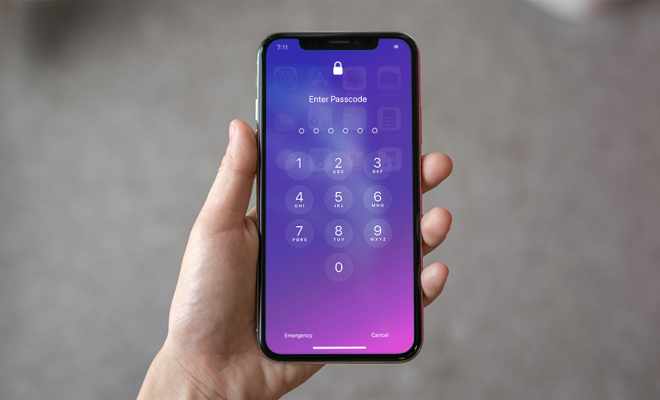
What Causes AMOLED Burn-In? How to Fix, Avoid, and Prevent It
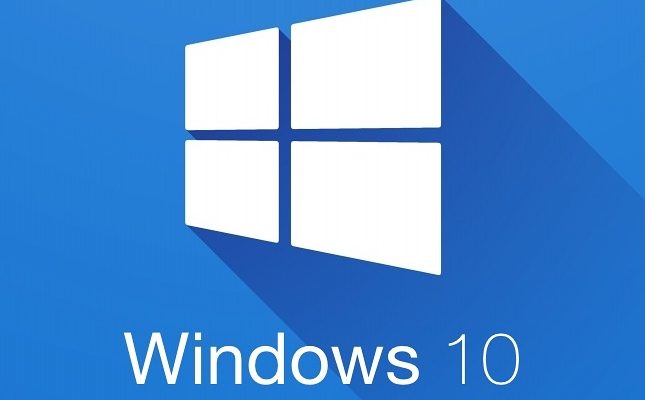
How to Change Icon Sizes in Windows 10

How to Use Green Screen Overlays in CapCut

What Is a GPU (Graphics Processing Unit)?

What Is Swapfile.sys in Windows, and Can You Delete It?

How to Add Devices on Amazon
How to manage and remove download items in Safari for Mac
When you download items in Safari, they are all easily accessible from the toolbar. You can see them, pause and resume them, and clear them away.
Here’s how to manage and remove download items in Safari for Mac.

View your downloads
You can see your downloads in two different ways in Safari.
First, you can click View > Show Downloads in the menu bar.
Note: The Show Downloads option will be clickable only if you have some recent downloads.
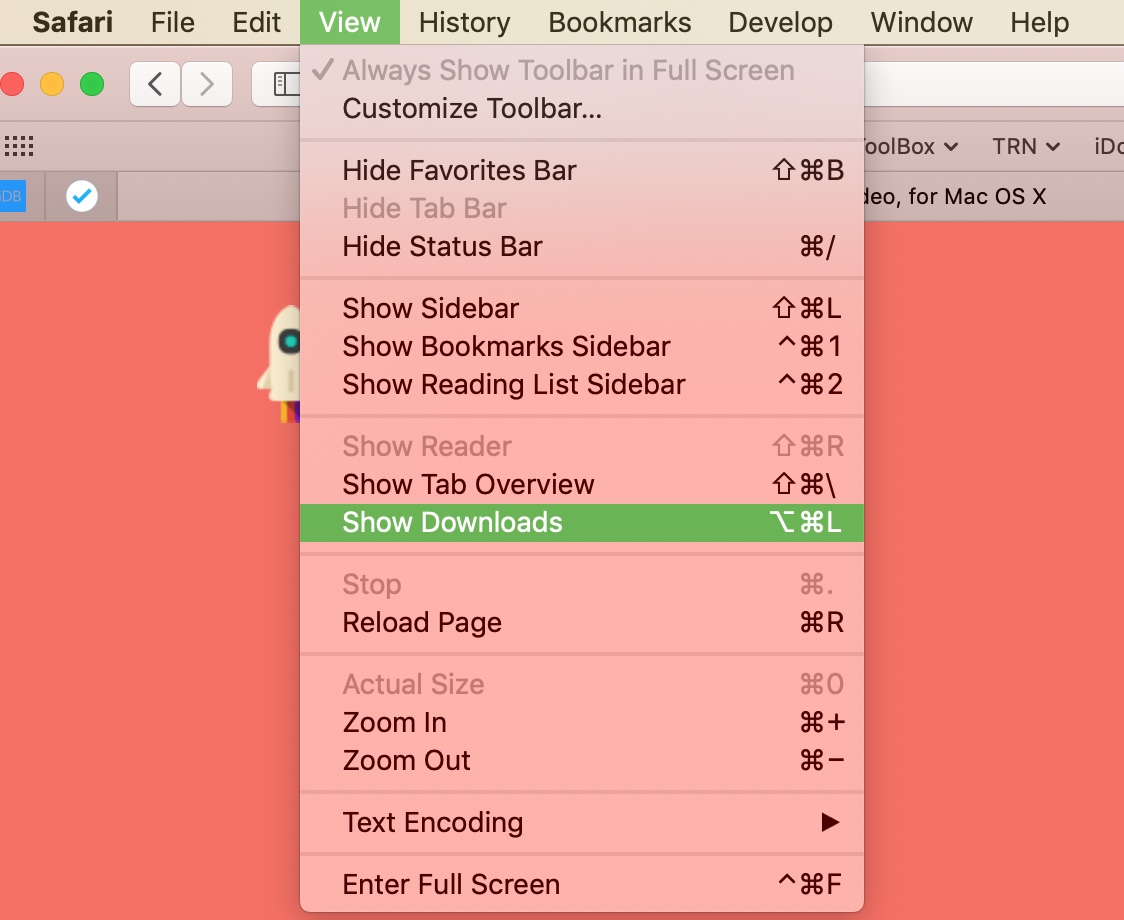
Second, you can click the Show Downloads button in the Safari toolbar.

Pause and resume downloads
Some files you download will take very little time, but large files can take a few minutes. So, if you decide that you don’t want to download a file after all, you may have time to pause or stop it:
- Click the Show Downloads button on the toolbar.
- Right-click on the download.
- Select Stop from the menu.
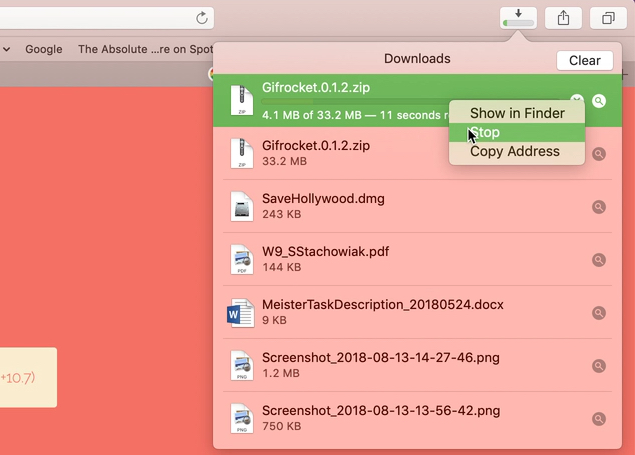
If you want to stop the download completely, you can also click the X next to the progress bar for the download.
If you want to resume downloading the file, right-click again and select Resume .
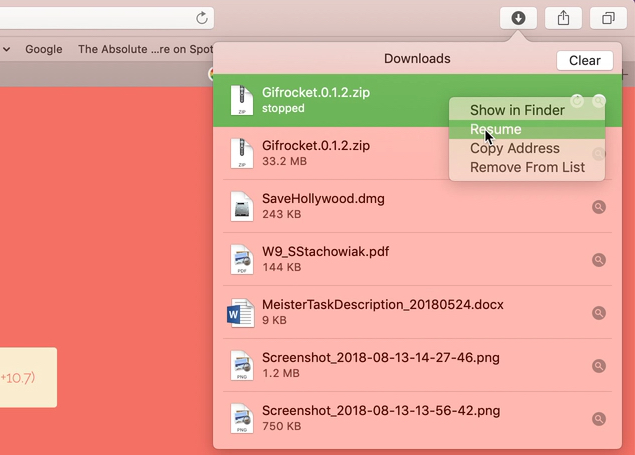
Remove downloads manually
You can manually remove downloads from the list one at a time or all at once. For all downloads, click the Show Downloads button in the toolbar and click Clear .
For individual removals:
- Select Remove from List from the menu.
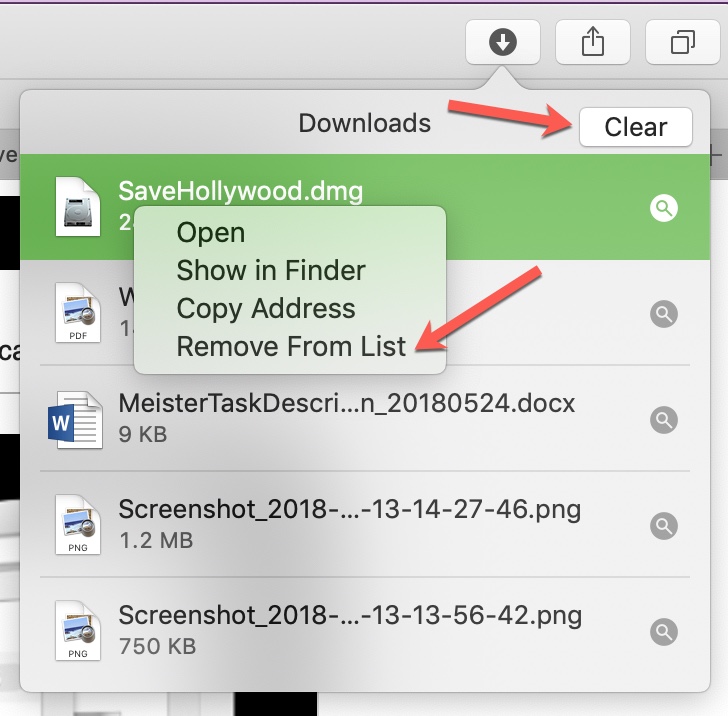
Remove downloads automatically
You can also have Safari clear your downloads for you automatically:
- Open Safari, click Safari in the top menu bar and select Settings or Preferences .
- On the General tab, click the Remove download list items drop-down box and choose from After one day , When Safari quits , or Upon successful download .
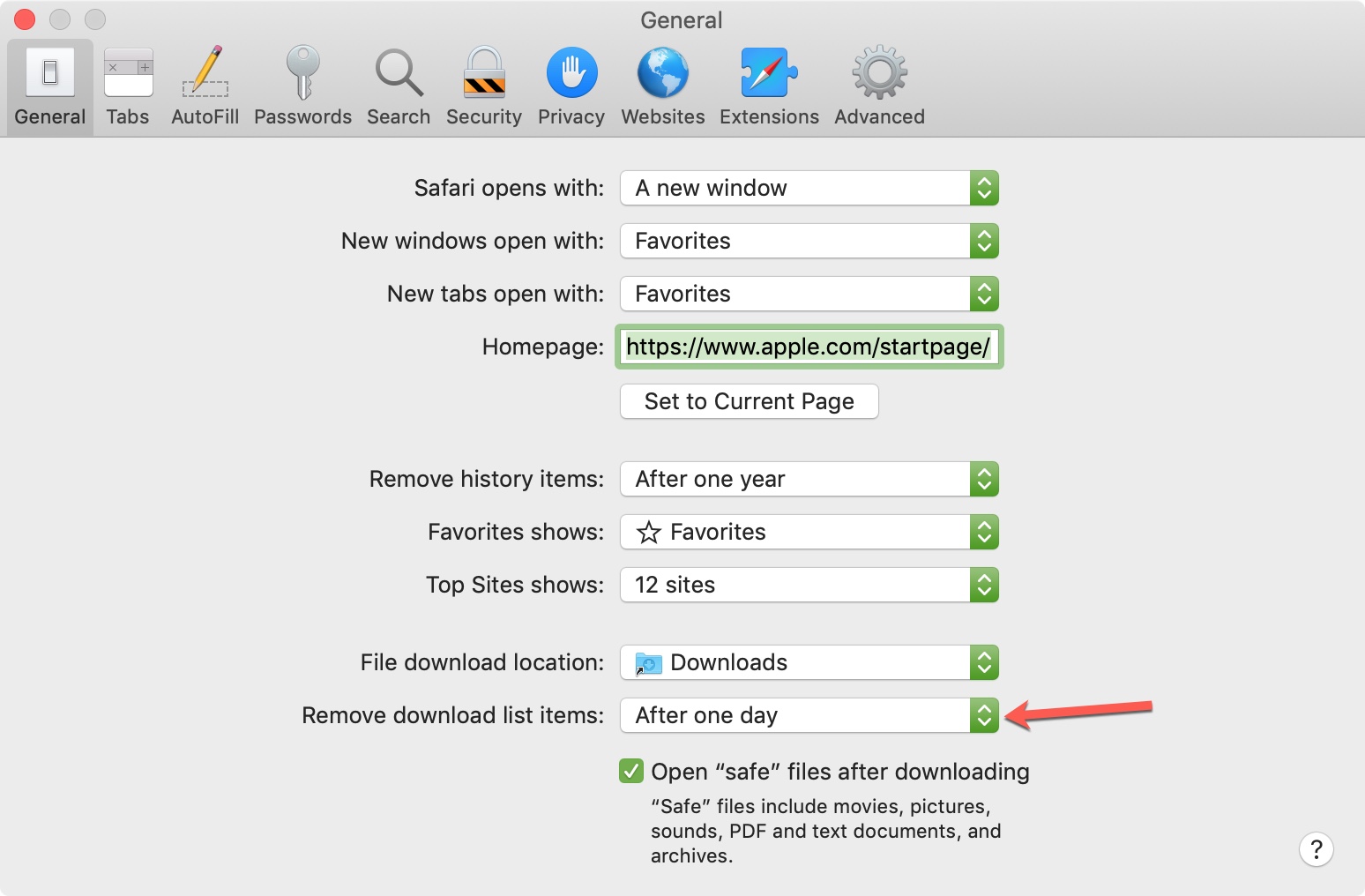
Change the download location
By default, your downloaded items will go into the Downloads folder . But you can change this if you like:
- Open Safari, click Safari in the menu bar and select Preferences .
- On the General tab, click the File download location drop-down box and choose the spot you want.
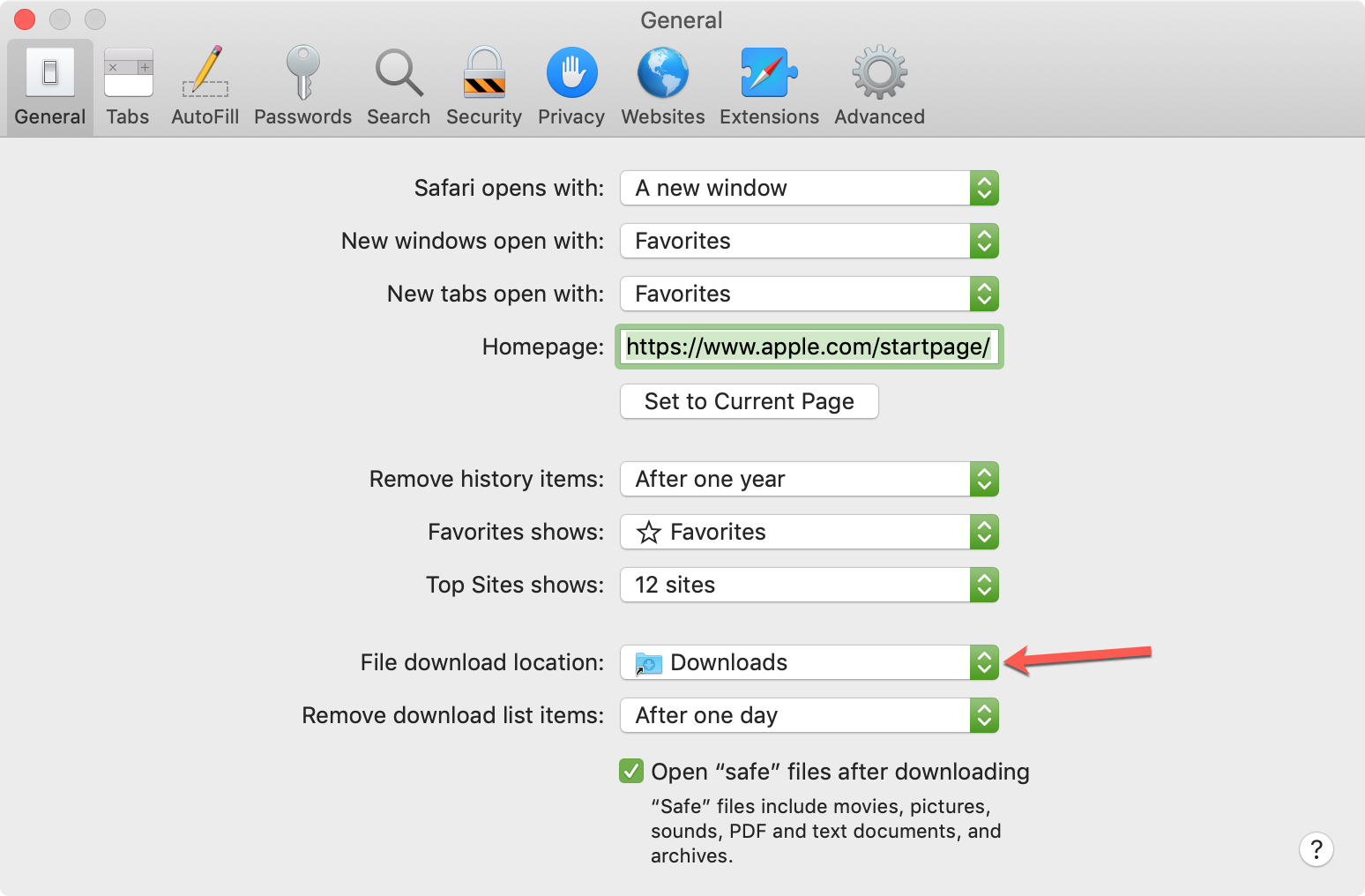
Hopefully, this tutorial helps answer any questions you have about managing your downloads. But if you still have more questions, feel free to leave a comment below.
Related tips:
- How to download videos from Safari on iPhone and iPad
- 10+ tips to customize and personalize Safari on iPhone and iPad
- How to change your Safari Homepage on Mac, iPhone, and iPad

How to Find Your Downloads on Your Mac
While browsing the web, you may download items such as documents, music, images or ebooks. Sometimes you may download apps from the Internet. When you download an item, you may be confused about where it went. I was very confused about this when I first switched to Mac from Windows. In this article, I will explain where the items you download end up on your Mac. I will also cover how you can change and customize your download settings.
What is the Downloads folder?
Your Mac has a folder called Downloads. This folder houses downloaded items, and it is located in your user account. The path is /Users/[username]/Downloads/. By default, a shortcut to Downloads will also be in the Dock and in the Finder sidebar. If you do not see the folder in the Dock or Finder sidebar, you can bring it back .
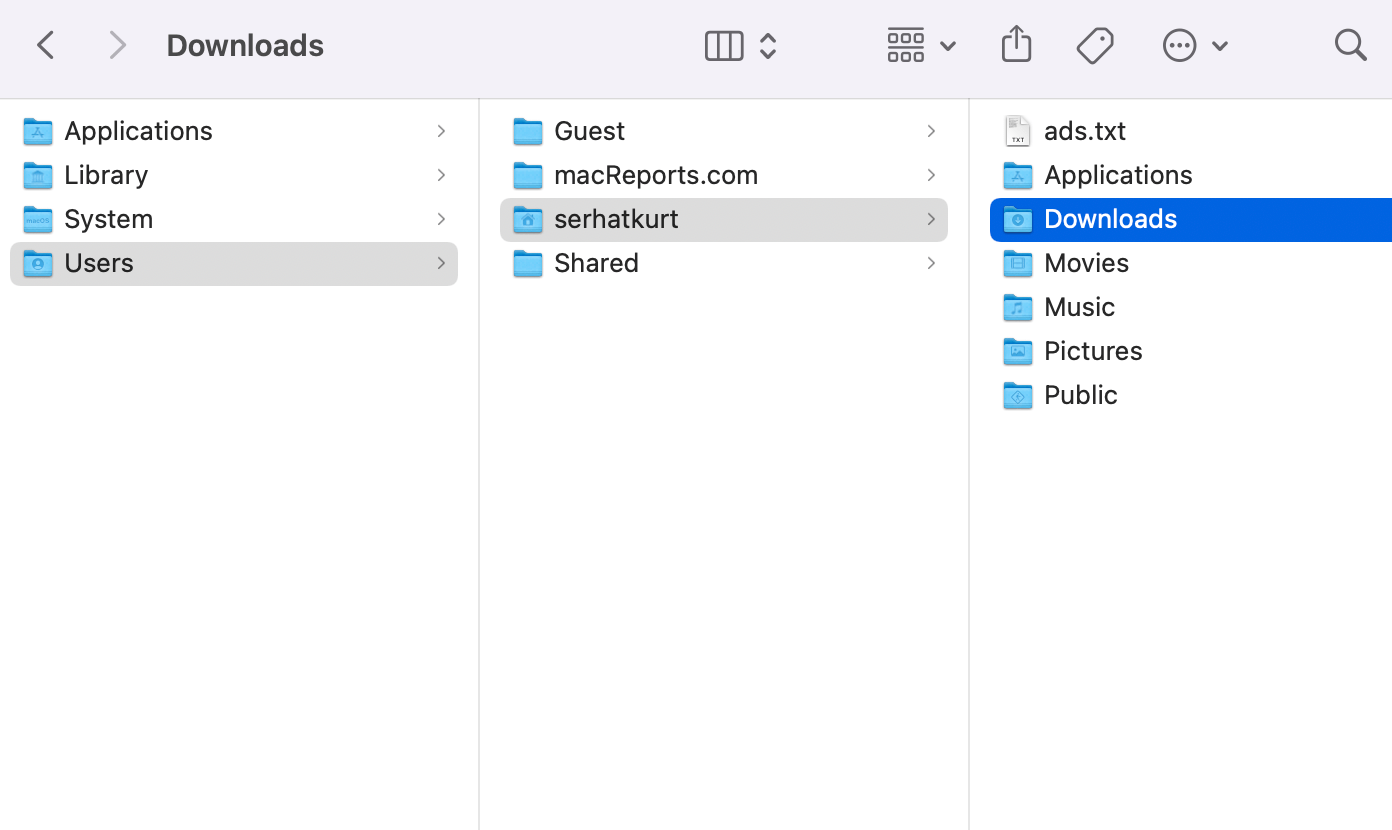
As I briefly explained above, the Downloads folder is the default location for your downloads. Below is a list of some of the items that are saved in this folder:
- Files or items downloaded from the Internet.
- Mail or Messages attachments.
- Files sent via AirDrop.
How to access the Downloads folder
There are a few ways to access the folder and locate your downloaded items:
- Dock: Your Dock lets you access the Downloads folder. Look next to the Trash icon. You will see a blue folder with a download symbol. Depending on your settings, it may also appear as a stack of items. This is why Downloads is also called a stack.

- Finder top menu: Open a Finder window, go to Go , then Downloads .
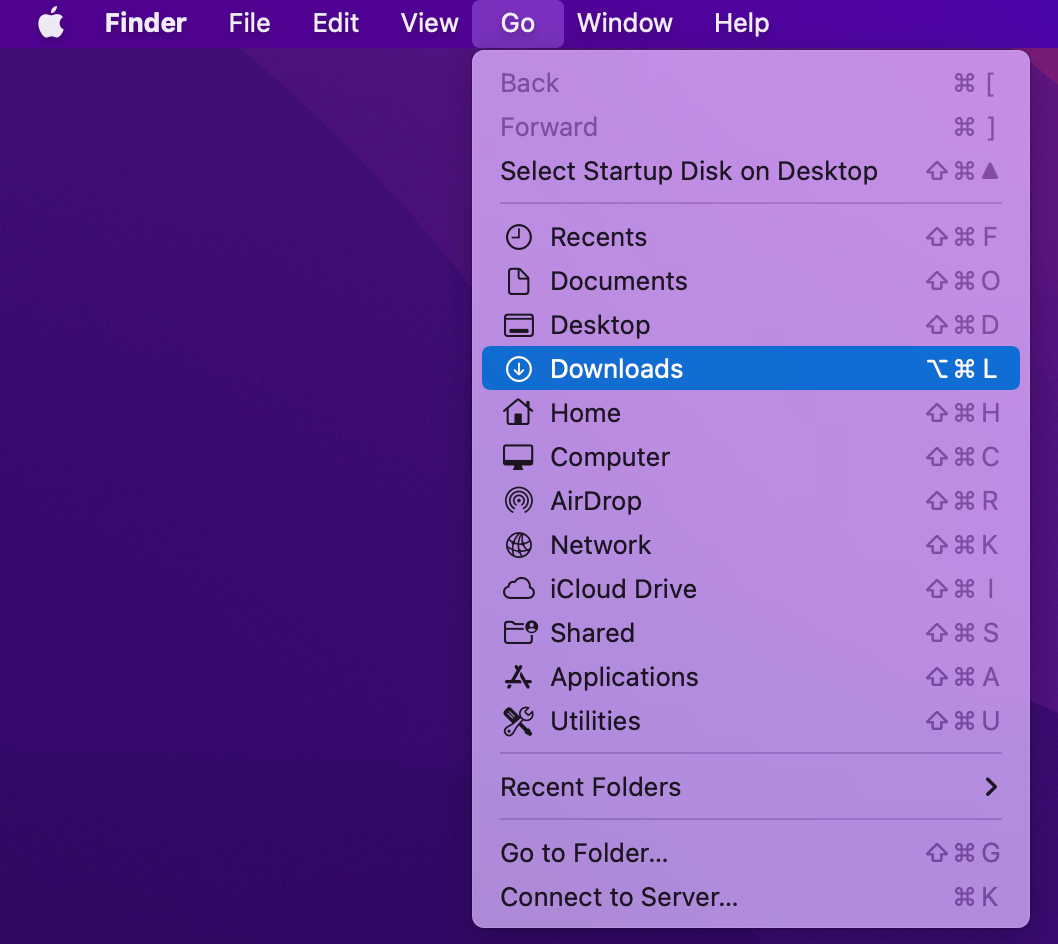
- Finder sidebar: Downloads will be available in the Finder sidebar.
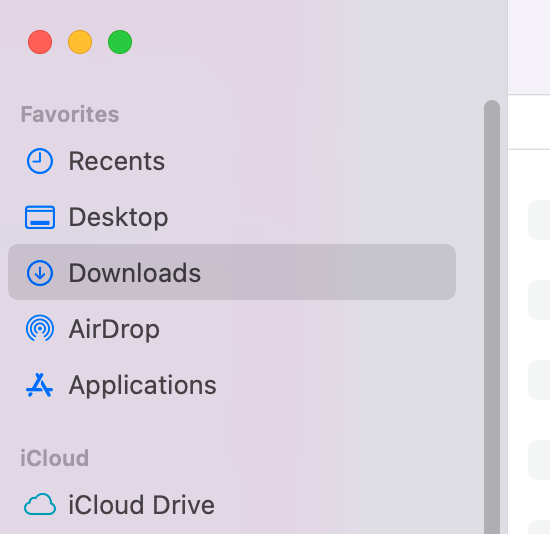
- Use a Shortcut: You can also use a shortcut to launch the folder. Using your keyboard, press these keys together: Option – Command – L .
How to change where your browser saves downloads
By default, your browser, such as Chrome or Safari, will save downloads to the Downloads folder, but you can change this. Here is how:
- Safari: With Safari open, from the top menu bar, go to Safari > Preferences > General . Locate the “File download location” option. If you want to save downloads to another folder, open the drop-down menu and select Other .
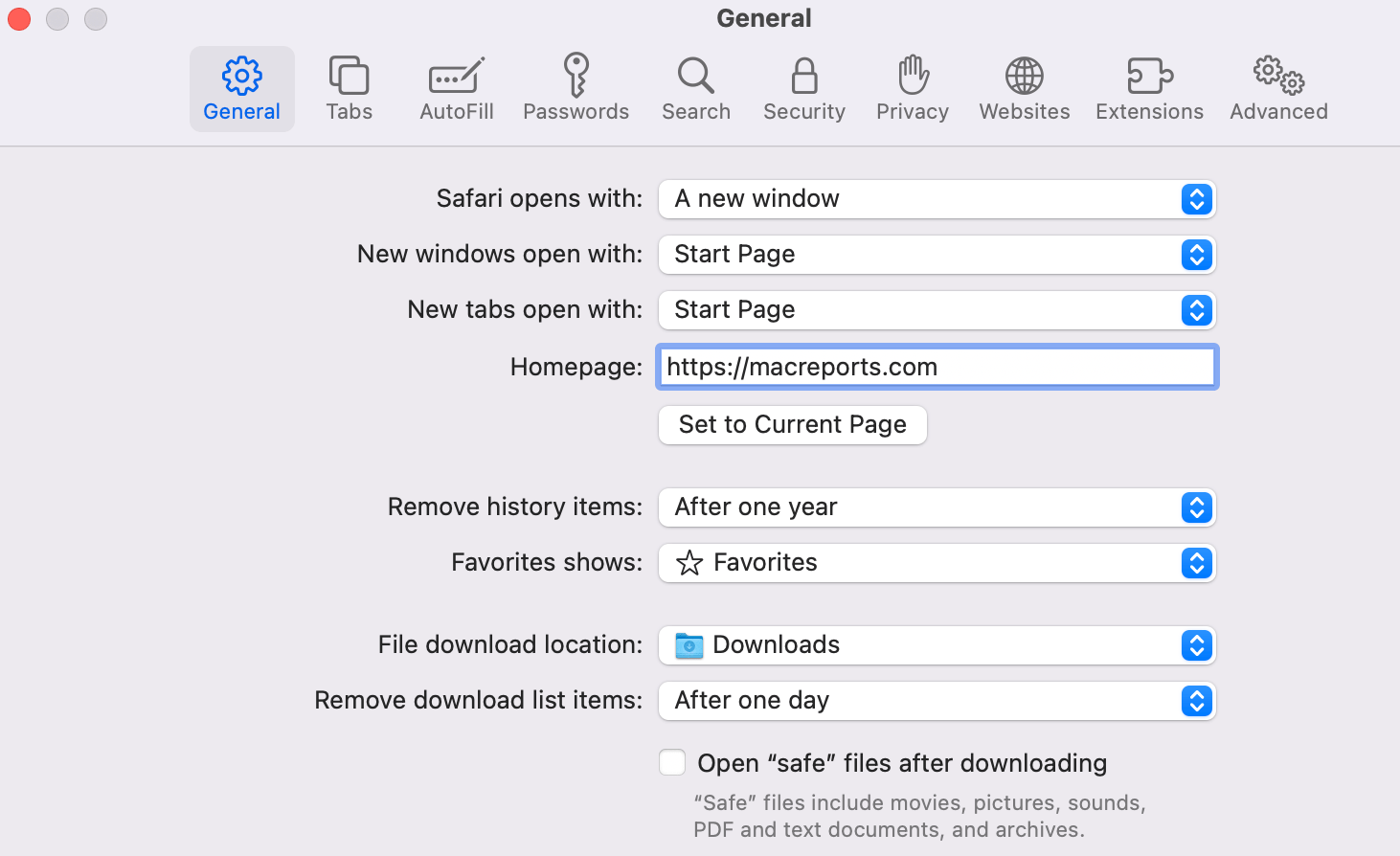
- Chrome: In Chrome, select Chrome > Preferences . From the sidebar, click Downloads , then click the Change button if you want to change the location.
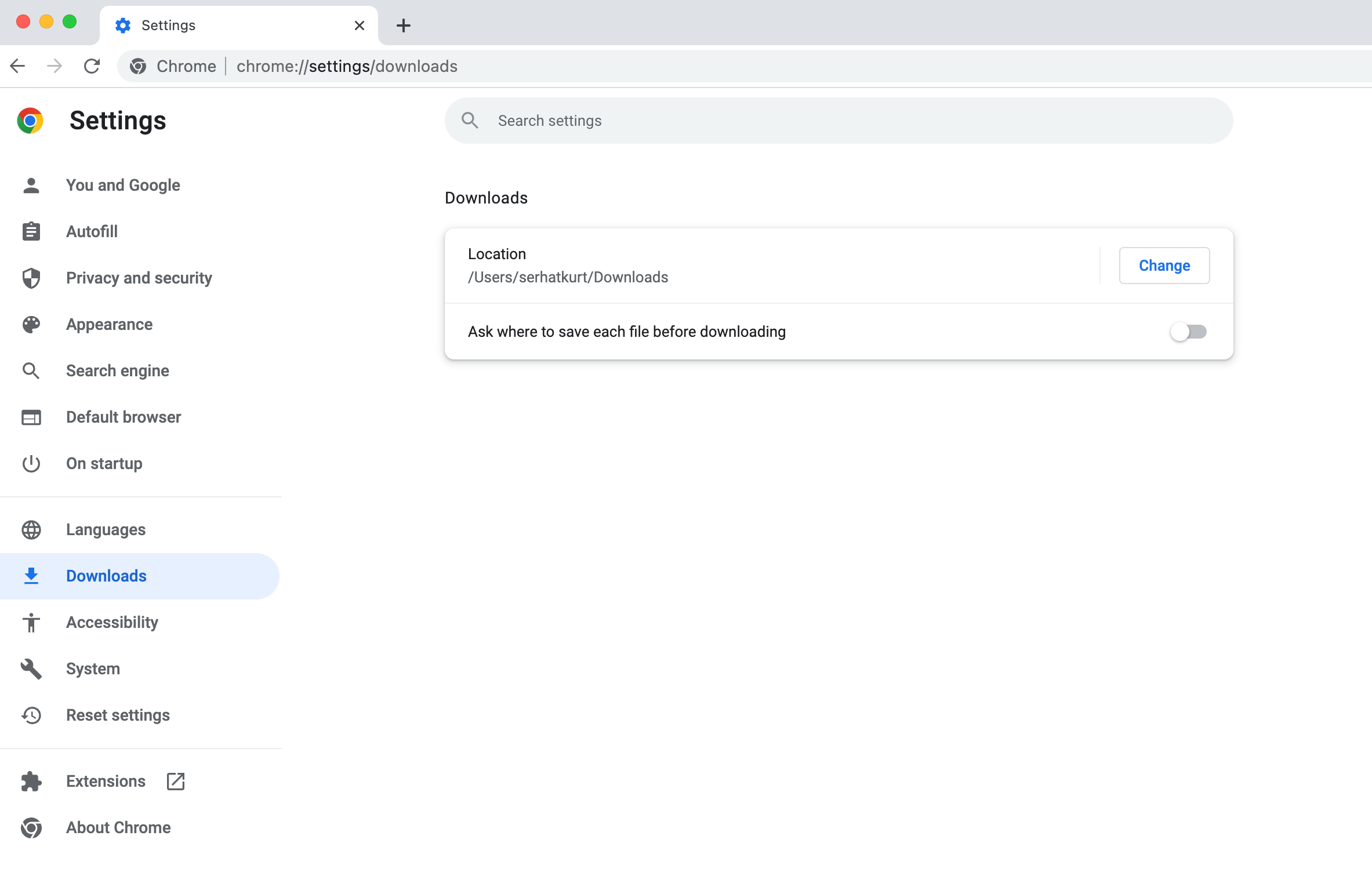
How to view your browser’s recently downloaded items
Safari has a download list. By default, the download list will be cleared after a day, but you can change this setting. If you want to do that, open Safari and click on Safari > Preferences and open the “Remove download list items” drop-down menu and select one of the options: after one day , when Safari quits , upon successful download or manually .
This list makes it easy for you to access your Safari downloads. It further helps you keep track of any currently downloading and already downloaded files. To view Safari downloads in Safari, click the Download button (if you do not see the button, your list is empty). The Download button is located near the top-right corner of the Safari window.
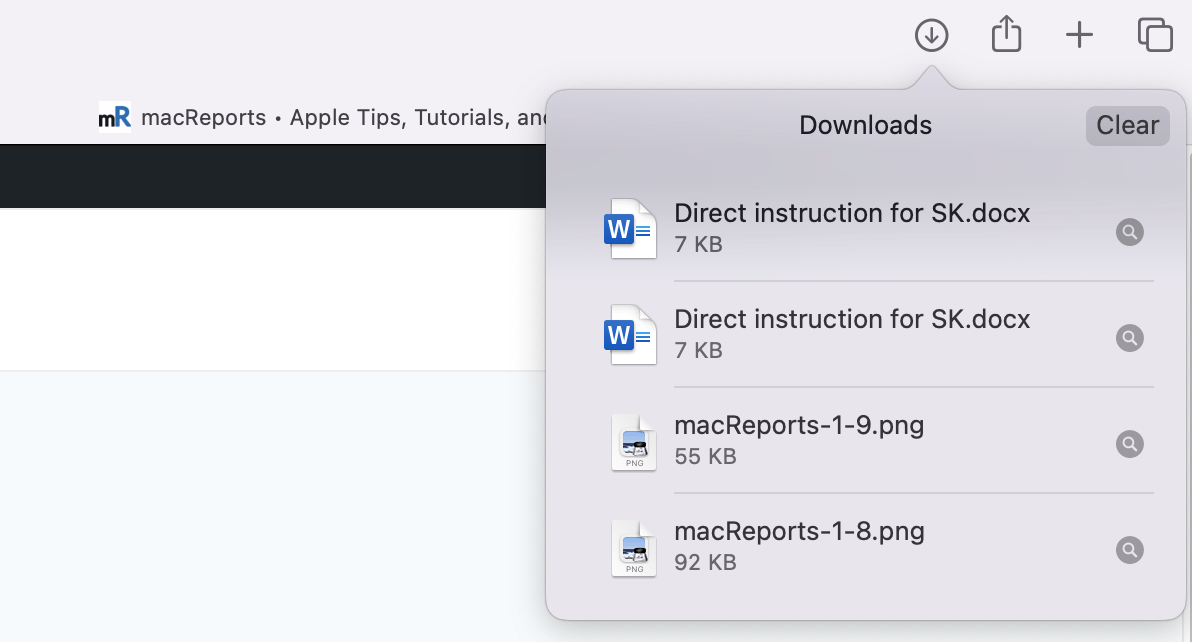
If you are using Chrome, Chrome has a similar list. To open the list of files you’ve downloaded, open Chrome, then click More and Downloads .
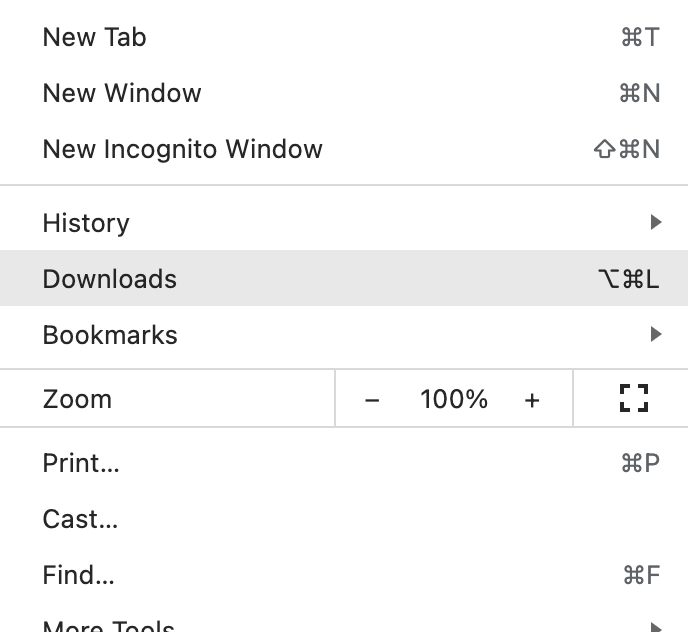
Related articles
- Where Do Downloads Go in Safari on iPhone or iPad?
- How To Download Zip Files Without Unzipping
- Cannot Download Photo: iCloud Library, Fix
Dr. Serhat Kurt worked as a Senior Technology Director specializing in Apple solutions for small and medium-sized educational institutions. He holds a doctoral degree (or doctorate) from the University of Illinois at Urbana / Champaign and a master’s degree from Purdue University. He is a former faculty member. Here is his LinkedIn profile and Google Scholar profile . Email Serhat Kurt .
Similar Posts
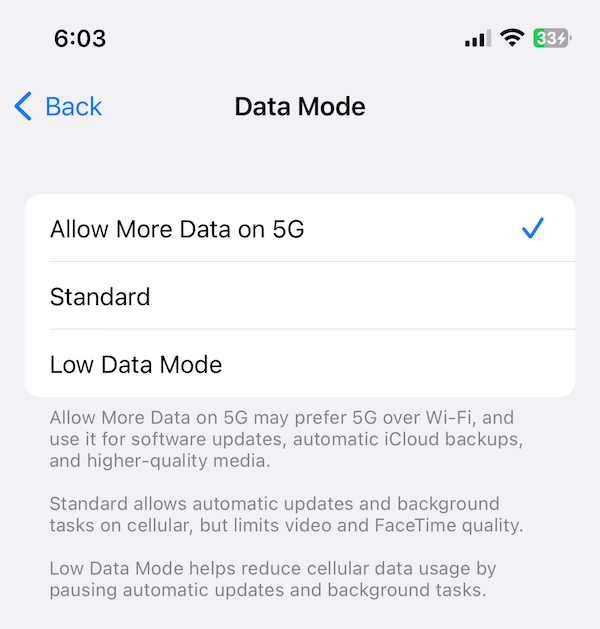
iOS 16: How to Reduce and Manage Your Cellular Data Usage on Your iPhone
Mobile (also called cellular) Data usage is how much data your iPhone transmits using cellular data. Cellular data is used to download and upload information when you are not connected to Wi-Fi or…
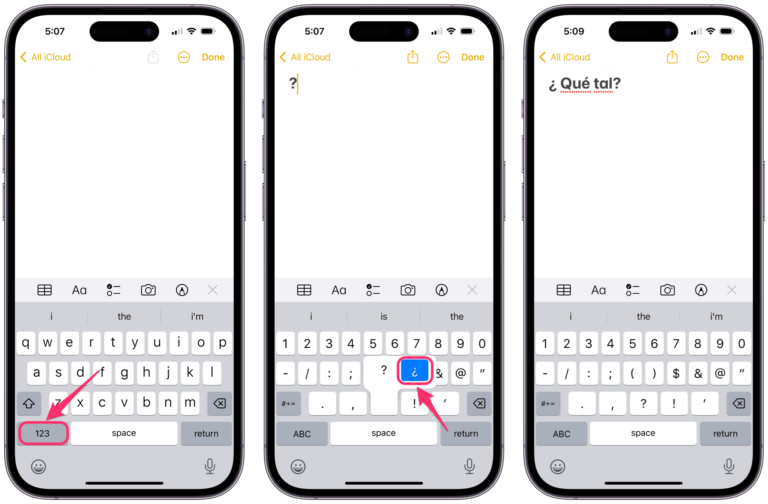
How to Type Spanish Upside-Down Question Mark on Mac, iPhone or iPad
If you are using a standard (English) keyboard with your Mac and you need to type an upside-down question mark (¿), like those found in Spanish (and some other languages), there are a…
How to use Automator on Mac to Rename Files
Automator for Mac is a built-in feature that you can use to automate big tasks that might otherwise take you a lot of time to complete, or small tasks that you do everyday…
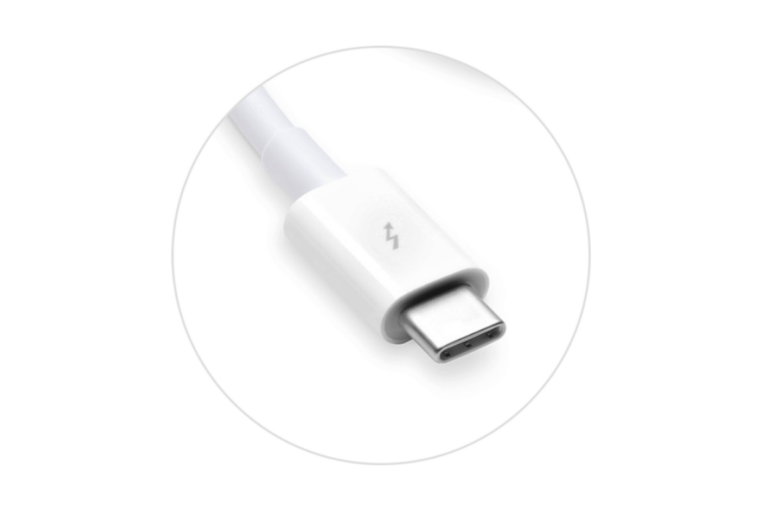
What Exactly Is Thunderbolt and How Is It Different From USB-C?
If you own a Mac, you have probably heard of Thunderbolt. But what is a Thunderbolt port or Thunderbolt cable, and how are they different from a regular USB-C port or cable? Many…
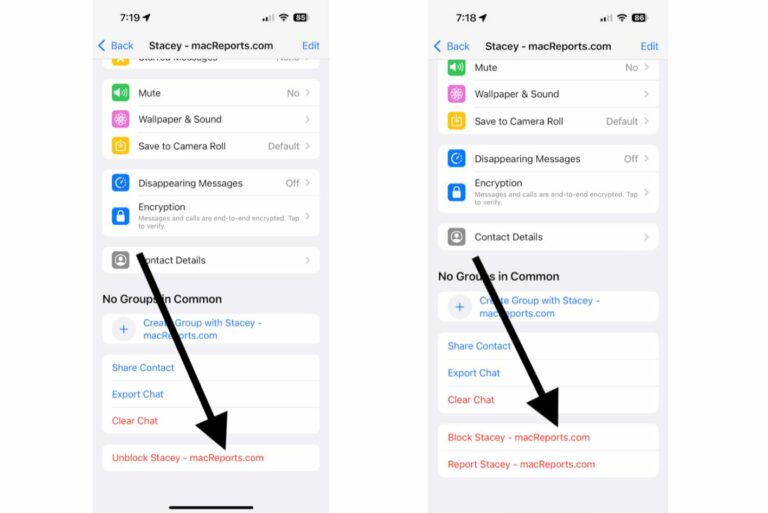
How to Block or Unblock People on WhatsApp for iPhone
WhatsApp is a very popular cross-platform communication app. You can use the app to text or call people over cellular data or Wi-Fi. A very handy feature WhatsApp offers is the ability to…
How to Use Google’s Hum to Search a Song on iPhone
Using Google to look up information about things is easy. At least, it is easy if you know what to type into the search field. When you want to know the title or…
Leave a Reply Cancel reply
Your email address will not be published. Required fields are marked *
Categories:
How to find downloads on your Mac computer in 3 ways
- It's easy to find downloads on your Mac computer in three different ways.
- When you download a file on your Mac , you can find it in the downloads folder on the dock, or by navigating to that folder in Finder.
- You can also find the download in a web browser, like Safari or Google Chrome , if you still have that browser open after you've downloaded a file.
- Visit Business Insider's homepage for more stories .
A download is pretty much useless if you can't find it on your Mac .
But that won't be a problem for you, because we're about to discuss multiple quick and easy ways to locate files on your computer — both through web browsers and on the Mac's hard drive itself.
With these steps in mind, you'll be able to find any file you have downloaded, as long as you haven't deleted it.
Here's what you need to know.
Check out the products mentioned in this article:
Macbook pro (from $1,299.99 at best buy), how find downloads on your mac in the dock.
Those icons at the bottom of your screen – the ones that give quick access to programs – comprise the dock, and in that dock is a quick link to your downloads. It's usually at the bottom right.
Hover over it for a quick preview of the most recent downloads or single-click the dock download icon for access to all your downloaded files that have yet to be placed in another folder.
How to find downloads on your Mac using Finder
When the taskbar at the top of the screen says Finder (and it will when you are on your Mac's home screen), click File, then click New Finder Window.
On the left side of the window that pops up, click Downloads.
How to find downloads on your Mac in a web browser
If the browser where you downloaded a file is still open, you can pull up the download right then and there.
In Google Chrome, click the three dots at the top right corner, then click Downloads.
With Safari, click the downward arrow at the top right corner of the screen to open a menu of recent downloads.
Related coverage from How To Do Everything: Tech :
How to make a zip file on your mac computer, to save some storage space and clear digital clutter, how to view hidden files on a mac computer in 2 different ways, to find out more information about your operating system, how to create folders on a mac computer and organize your files, how to open a rar file on your mac computer, for downloading or sharing a large number of files.
Insider Inc. receives a commission when you buy through our links.
Watch: 4 easy ways to transform your countertops
- Main content
How to Find Recently Downloaded Files on Mac
- June 2, 2023
Table of Contents
Have you ever found yourself in a situation where you downloaded a file on your Mac, but you can’t seem to locate it? Have you tried to search for the file, only to find that it’s not in the Downloads folder or on your desktop? This can be frustrating, especially when you need to access the file immediately. Luckily, there are several ways to find recently downloaded files on your Mac, whether you remember the file name or not.
In this blog post, we’ll show you a few methods to find recently downloaded files on your Mac. We’ll also provide some helpful tips, and answer some frequently asked questions to help you find your downloaded files more efficiently.
Video Tutorial:
Why you need to find recently downloaded files on mac.
As we do on our Macs, we download several files every day, from images, music files, PDFs to project files, etc. When you download these files, they’re usually saved in the Downloads folder or on your desktop. However, during the course of the day, you might download several files, and some of them might be buried deep down in some folders.
It’s essential to locate your recently downloaded files on Mac, and why? First, the file might contain vital information that you need to access urgently. Second, the file might contain a virus that’s harming your Mac. Third, you might need the file to complete a project or a task.
To avoid the frustration of searching for downloaded files on your Mac, you need to know how to find recently downloaded files on your Mac.
Method 1: Via Finder
The easiest way to search for your recently downloaded files in the Finder is by using the Spotlight search tool. You can find this tool on the top right corner of your screen or by simply using the Command + Space keyboard shortcut. Follow the steps below to find recently downloaded files via Finder:
- Click the Spotlight search tool on the top right corner of your screen or use the keyboard shortcut (Command + Space).
- Type in the name of the recently downloaded file in the search bar.
- Click the Show all in Finder button that appears below the search results to see all the files that match your search.
- Refine your search results by using specific search filters or drop-down menus if necessary.
- Quick and accessible
- Not efficient for finding files with file extensions or hidden.
Method 2: Using the Downloads Folder
If you’ve recently downloaded a file, and you’re unsure of where it’s been saved, there’s a high chance it could be in your Downloads folder. The Downloads folder is one of the default folders that Mac creates to store downloaded files. Follow the steps below to find recently downloaded files in the Downloads folder:
- On your desktop, click on the Downloads folder on the dock.
- Scroll through the folder to find the file.
- If the file isn’t on the first page, click the date modified column to sort the files based on the most recent download date.
- If the file isn’t in the Downloads folder, open a new Finder window, and check the Desktop, Documents, or iCloud folder.
- Files are relatively easier to find using this method
- You might accidentally delete some files while searching for your downloaded files.
Method 3: Using Terminal
You can also use Terminal to find recently downloaded files on your Mac. Terminal is the command-line utility on your Mac that allows you to execute different commands and control various aspects of your Mac. To use Terminal to find recently downloaded files, follow the steps below:
- Go to Applications > Utilities > Terminal .
- Type in the following command, substituting <file type> with the type of file you want to find: find ~/Downloads -type f -name "*.<file type>" -mtime -1
- Press Enter to run the command.
- The results will show all the recently downloaded files of that specific file type in the Downloads folder that were modified within the last 24 hours (mtime -1).
- This method is suitable for finding hidden files and files with extensions.
- Terminal is complex, and if you enter the wrong command, it might harm your system.
- It’s time-consuming to find a recently downloaded file of a specific file type.
What to Do If You Can’t Find Recently Downloaded Files on Mac
If you’ve tried all the methods above and still can’t find your recently downloaded files on your Mac, here are some things you can do:
- Check the Trash folder: it’s possible that you might have accidentally deleted the downloaded file, and it’s still in the Trash folder.
- Check other folders: If you remember the name of the file or the application used to download the file, you can try to find it in the appropriate folders.
- Use a third-party app: You can use third-party apps like EasyFind or Tembo to find files on your Mac easily.
- Restore a previous version: If you accidentally deleted the file or lost it due to a system error, you can try to restore a previous version of the file.
Bonus Tip: Auto-Downloads Folders
Auto-Downloads folders are folders that some apps create automatically to store downloaded files. For example, web browsers like Chrome and Safari usually have separate Downloads folders that you can access from the app’s menu bar. To access these auto-downloads folders:
- Launch the app where you downloaded the file from (e.g., Chrome or Safari).
- Click on the menu bar, then click Downloads, and select Show in Finder.
5 FAQs About Finding Recently Downloaded Files on Mac
Q1. how do i see my most recent downloads on mac.
A: You can see your most recent downloads on Mac by opening the Downloads folder or clicking the downloads icon in your dock. Alternatively, you can use Finder or Terminal to search for recently downloaded files.
Q2. How do I view my download history in Safari on Mac?
A: To view your download history in Safari on Mac, click on the Safari menu bar, then click on the Downloads icon. This will show you all the files you’ve downloaded.
Q3. How do I clear my download history on Mac?
A: To clear your download history on Mac, open Safari and click on the Safari menu bar. Then click on " Clear History " and select " all history " from the drop-down menu. This will remove all your browsing history and downloaded files history from Safari.
Q4. How do I recover deleted files on Mac?
A: You can recover deleted files on Mac by opening the Trash folder and restoring the files you need. Alternatively, you can use Time Machine to restore a previous version of the file, or use data recovery software to recover your deleted files.
Q5. How can I prevent losing my downloaded files on Mac?
A: To prevent losing your downloaded files on Mac, it’s advisable to create a specific folder where you save all your downloaded files. You can also use a backup software like Time Machine or cloud storage to store your files safely.
Final Thoughts
Downloading files on Mac is a common activity, but finding recently downloaded files can be challenging, especially if you don’t remember the file name or the folder where it’s been saved. This blog post has outlined a few methods to find recently downloaded files on your Mac, from using Finder, the Downloads folder to Terminal. We’ve also provided some helpful tips and answered some frequently asked questions. We hope this article has been helpful to you. If you have any further questions, feel free to leave a comment below.
You Might Also Like
How to play nintendo switch games on mac, how to create mac os x lion bootable usb, how to do universal control on mac and ipad, how to combine two documents into one pdf mac, how to connect a monitor to a mac laptop, cleanmydrive 2 review – simplified and effortless mac disk manager., the best 6 image extractors for mac – extract images like a pro, how to add error bars in excel on mac.
Safari Browser will not download files.
The download icon pops up quickly on Safari address bar, then disappears, ~0.5 sec.
File cannot be found anywhere.
Have tried:
"Safari"/ "Settings"/ "General"/ "File download location:"/ ( using different Folders ),
"Safari"/ "History"/ "Clear History"/ ( deleting browser history),
"Safari"/ "Settings"/ "Privacy"/ "Website data"/ (deleting data),
How to download in "Terminal" App ? Will that work ?
macOS Sonoma 14.4.1,
MacBook Pro,
MacBook Pro 14″, macOS 14.4
Posted on Apr 25, 2024 8:50 PM
Loading page content
Page content loaded
There are no replies.
- Press Releases
- Industry News
- Product Spotlight
- Fresh from Apple
- Video Production
- Installation Videos
- Explainer Videos
- Testing Lab
- Networking & Security
- Special OWC Deals
- The Other World
- Powered by OWC
- Space & Beyond
- Random Thoughts & Topics
- OWC Unplugged
- Article Archives
- Make a Suggestion

Send us a Topic or Tip
Have a suggestion for the blog? Perhaps a topic you'd like us to write about? If so, we'd love to hear from you! Fancy yourself a writer and have a tech tip, handy computer trick, or "how to" to share? Let us know what you'd like to contribute!
macOS 101: How to Manage, View Downloads in Safari
In the macOS Safari web browser , you can choose where downloaded files are deposited. By default they’re located in your Downloads folder.
You can find the Downloads folder by going to the Users folder on your Mac’s hard drive and clicking User. You’ll see it listed along with folders for Desktop, Documents, Movies, Music, Pictures, and Public.
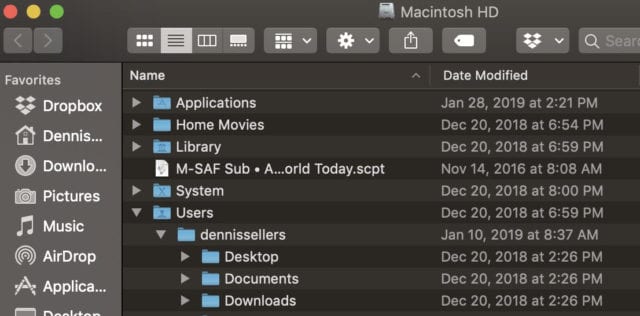
To change where the downloads go, go to Safari’s Preferences and select General. You’ll see a dialog box that allows you to select the file download location, as well as determine how often you want downloaded items automatically removed from your Mac: after one day, when you Mac shuts down, after a successful download, or manually.
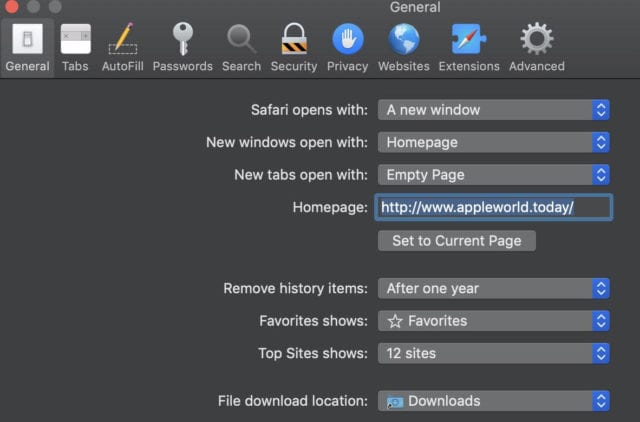
You can also choose whether to automatically open “safe” files after they’ve downloaded. Safe files include movies, pictures, sounds, PDF and text documents, and archives.
In Safari, you can click on anything identified as a download link, or Control-click an image or other object on the page. To choose to download a linked file (and some webpage items can’t be downloaded, in Safari click the Show Downloads button near the top-right corner of the web browser window.
If there are no downloads, the button won’t appear. If files are currently being downloaded, you can use the button to pause and resume them.
Other Topics You Might Like:
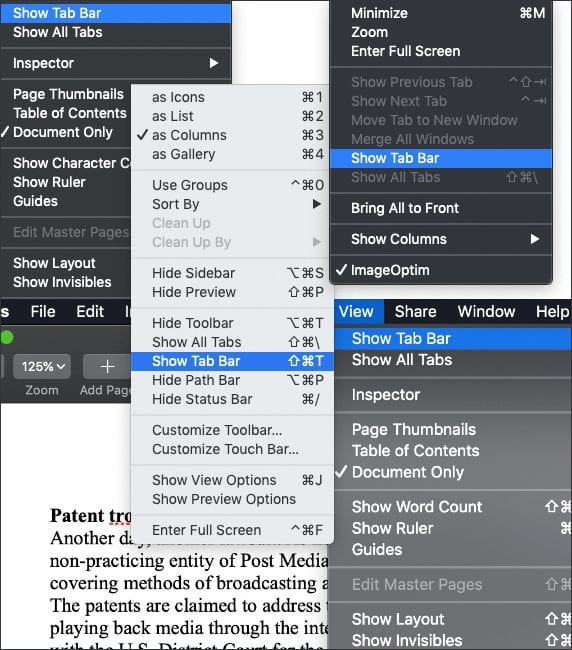
Leave a Reply Cancel reply
Save my name, email, and website in this browser for the next time I comment.
Notify me of follow-up comments by email.
Notify me of new posts by email.
Plesae help me upgrade safarie in my MacBookAir 13″-version OS X 10.10.5
You Might Also Like

How to Share Security Certificates in macOS Sonoma

At OWC Earth Day is Every Day
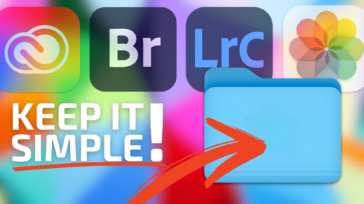
Keep it Simple! Don’t Trust Your Photo Library’s Organization to Cloud and Editing Apps

How to Control your Mac, Windows and Linux Machines with One Keyboard and Mouse
Email Address

- Brand Assets

8 Galaxy Way Woodstock, IL 60098 1-800-275-4576 +1-815-338-8685 (Int)
All Rights Reserved, Copyright 2020, OWC – Since 1988 | Terms of Use | Privacy Policy
We use cookies to provide you with a full shopping experience, including personalized content, and to help us improve your experience. To learn more, click here .
By continuing to use our site, you accept our use of Cookies, Privacy Policy and Terms of Use .
About iOS 17 Updates
iOS 17 brings big updates to Phone, Messages, and FaceTime that give you new ways to express yourself as you communicate. StandBy delivers a new full-screen experience with glanceable information designed to view from a distance when you turn iPhone on its side while charging. AirDrop makes it easier to share and connect with those around you and adds NameDrop for contact sharing. Enhancements to the keyboard make entering text faster and easier than ever before. iOS 17 also includes updates to Widgets, Safari, Music, AirPlay, and more.
For information on the security content of Apple software updates, please visit this website: https://support.apple.com/kb/HT201222
This update provides important bug fixes and security updates and is recommended for all users.
For information on the security content of Apple software updates, please visit this website:
https://support.apple.com/kb/HT201222
This update introduces new emoji, transcripts in Apple Podcasts and includes other features, bug fixes, and security updates for your iPhone.
New mushroom, phoenix, lime, broken chain, and shaking heads emoji are now available in the emoji keyboard
18 people and body emoji add the option to face them in either direction
Apple Podcasts
Transcripts let you follow an episode with text that highlights in sync with the audio in English, Spanish, French and German
Episode text can be read in full, searched for a word or phrase, tapped to play from a specific point and used with accessibility features such as Text Size, Increase Contrast, and VoiceOver
This update includes the following enhancements and bug fixes:
Music recognition lets you add songs you have identified to your Apple Music Playlists and Library, as well as Apple Music Classical
Siri has a new option to announce messages you receive in any supported language
Stolen Device Protection supports the option for increased security in all locations
Battery Health in Settings shows battery cycle count, manufacture date, and first use on iPhone 15 and iPhone 15 Pro models
Call Identification displays Apple-verified business name, logo, and department name when available
Business updates in Messages for Business provide trusted information for order status, flight notifications, fraud alerts or other transactions you opt into
Apple Cash virtual card numbers enable you to pay with Apple Cash at merchants that don’t yet accept Apple Pay by typing in your number from Wallet or using Safari AutoFill
Fixes an issue where contact pictures are blank in Find My
Fixes an issue for Dual SIM users where the phone number changes from primary to secondary and is visible to a group they have messaged
Some features may not be available for all regions or on all Apple devices. For information on the security content of Apple software updates, please visit this website:
This update provides bug fixes for your iPhone including:
Text may unexpectedly duplicate or overlap while typing
This update introduces additional security measures with Stolen Device Protection. This release also includes a new Unity wallpaper to honor Black history and culture in celebration of Black History Month, as well as other features, bug fixes, and security updates for your iPhone.
Stolen Device Protection
Stolen Device Protection increases security of iPhone and Apple ID by requiring Face ID or Touch ID with no passcode fallback to perform certain actions
Security Delay requires Face ID or Touch ID, an hour wait, and then an additional successful biometric authentication before sensitive operations like changing device passcode or Apple ID password can be performed
Lock Screen
New Unity wallpaper honors Black history and culture in celebration of Black History Month
Collaborate on playlists allows you to invite friends to join your playlist and everyone can add, reorder, and remove songs
Emoji reactions can be added to any track in a collaborative playlist
This update also includes the following improvements:
AirPlay hotel support lets you stream content directly to the TV in your room in select hotels
AppleCare & Warranty in Settings shows your coverage for all devices signed in with your Apple ID
Crash detection optimizations (all iPhone 14 and iPhone 15 models)
This update provides important bug fixes and is recommended for all users.
This update introduces Journal, an all-new way to reflect on life’s moments and preserve your memories. This release also includes Action button and Camera enhancements, as well as other features, bug fixes, and security updates for your iPhone.
Journal is a new app that lets you write about the small moments and big events in your life so you can practice gratitude and improve your wellbeing
Journaling suggestions make it easy to remember your experiences by intelligently grouping your outings, photos, workouts, and more into moments you can add to your journal
Filters let you quickly find bookmarked entries or show entries with attachments so you can revisit and reflect on key moments in your life
Scheduled notifications help you keep a consistent journaling practice by reminding you to write on the days and time you choose
Option to lock your journal using Touch ID or Face ID
iCloud sync keeps your journal entries safe and encrypted on iCloud
Action Button
Translate option for the Action button on iPhone 15 Pro and iPhone 15 Pro Max to quickly translate phrases or have a conversation with someone in another language
Spatial video lets you capture video on iPhone 15 Pro and iPhone 15 Pro Max so you can relive your memories in three dimensions on Apple Vision Pro
Improved Telephoto camera focusing speed when capturing small faraway objects on iPhone 15 Pro and iPhone 15 Pro Max
Catch-up arrow lets you easily jump to your first unread message in a conversation by tapping the arrow visible in the top-right corner
Add sticker option in the context menu lets you add a sticker directly to a bubble
Memoji updates include the ability to adjust the body shape of any Memoji
Contact Key Verification provides automatic alerts and Contact Verification Codes to help verify people facing extraordinary digital threats are messaging only with the people they intend
Precipitation amounts help you stay on top of rain and snow conditions for a given day over the next 10 days
New widgets let you choose from next-hour precipitation, daily forecast, sunrise and sunset times, and current conditions such as Air Quality, Feels Like, and wind speed
Wind map snapshot helps you quickly assess wind patterns and access the animated wind map overlay to prepare for forecasted wind conditions for the next 24 hours
Interactive moon calendar lets you easily visualize the phase of the moon on any day for the next month
This update also includes the following improvements and bug fixes:
Siri support for privately accessing and logging Health app data using your voice
AirDrop improvements including expanded contact sharing options and the ability to share boarding passes, movie tickets, and other eligible passes by bringing two iPhones together
Favorite Songs Playlist in Apple Music lets you quickly get back to the songs you mark as favorites
Use Listening History in Apple Music can be disabled in a Focus so music you listen to does not appear in Recently Played or influence your recommendations
A new Digital Clock Widget lets you quickly catch a glimpse of the time on your Home Screen and while in StandBy
Enhanced AutoFill identifies fields in PDFs and other forms enabling you to populate them with information such as names and addresses from your contacts
New keyboard layouts provide support for 8 Sámi languages
Sensitive Content Warning for stickers in Messages prevents you from being unexpectedly shown a sticker containing nudity
Qi2 charger support for all iPhone 13 models and iPhone 14 models
Fixes an issue that may prevent wireless charging in certain vehicles
This update provides important security fixes and is recommended for all users.
In rare circumstances, Apple Pay and other NFC features may become unavailable on iPhone 15 models after wireless charging in certain cars
Weather Lock Screen widget may not correctly display snow
This update introduces the ability for AirDrop transfers to continue over the internet when you step out of AirDrop range. This release also includes enhancements to StandBy and Apple Music, as well as other features, bug fixes, and security updates for your iPhone.
Content continues to transfer over the internet when you step out of AirDrop range
New options to control when the display turns off (iPhone 14 Pro, iPhone 14 Pro Max, iPhone 15 Pro, and iPhone 15 Pro Max)
Favorites expanded to include songs, albums, and playlists, and you can filter to display your favorites in the library
New cover art collection offers designs that change colors to reflect the music in your playlist
Song suggestions appear at the bottom of every playlist, making it easy to add music that matches the vibe of your playlist
Option to choose a specific album to use with Photo Shuffle on the Lock Screen
Home key support for Matter locks
Improved reliability of Screen Time settings syncing across devices
Fixes an issue that may cause the Significant Location privacy setting to reset when transferring an Apple Watch or pairing it for the first time
Resolves an issue where the names of incoming callers may not appear when you are on another call
Addresses an issue where custom and purchased ringtones may not appear as options for your text tone
Fixes an issue that may cause the keyboard to be less responsive
Fixes an issue that may cause display image persistence
https://support.apple.com/HT201222
This update provides important bug fixes, security updates, and addresses an issue that may cause iPhone to run warmer than expected.
This update provides important bug fixes, security updates, and fixes an issue that may prevent transferring data directly from another iPhone during setup.
Contact Posters let you customize how you appear on other people’s devices when you call them with a customized poster
Live Voicemail displays a live transcription as someone leaves a message and allows you to pick up the call
Stickers iMessage app brings all your stickers into one place including Live Stickers, Memoji, Animoji, emoji stickers, and your third party sticker packs
Live Stickers can be created by lifting the subject from photos or videos and stylizing them with effects like Shiny, Puffy, Comic, and Outline
Check In automatically notifies a family member or friend when you arrive at a destination safely and can share helpful information with them in case of a delay
Audio message transcription is available for audio messages you receive so you can read them in the moment and listen later
Search improvements help you find messages faster by allowing you to combine search filters such as people, keywords, and content types like photos or links to find exactly what you are looking for
Swipe to reply to a message inline by swiping to the right on any bubble
One-time verification code cleanup automatically deletes verification codes from the Messages app after using them with AutoFill in other apps
Leave a video or audio message to capture exactly what you want to say when someone does not pick up your FaceTime call
Enjoy FaceTime calls on Apple TV by using your iPhone as a camera (Apple TV 4K 2nd generation and later)
Reactions layer 3D effects like hearts, balloons, confetti, and more around you in video calls and can be triggered with gestures
Video effects allow you to adjust the intensity of Studio Lighting and Portrait mode
Full-screen experience with glanceable information like clocks, photos, and widgets designed to view from a distance when iPhone is on its side and charging in places such as your nightstand, kitchen counter, or desk
Clocks are available in a variety of styles including Digital, Analog, Solar, Float, and World Clock, with elements you can personalize like the accent color
Photos automatically shuffle through your best shots or showcase a specific album you choose
Widgets give you access to information at a distance and appear in Smart Stacks that deliver the right information at the right time
Night Mode lets clocks, photos, and widgets take on a red tone in low light
Preferred view per MagSafe charger remembers your preference for each place you charge with MagSafe, whether that’s a clock, photos, or widgets
Interactive widgets let you take actions, like mark a reminder as complete, directly from the widget by tapping it on the Home Screen, Lock Screen, or in StandBy
iPhone widgets on Mac enable you to add widgets from your iPhone to your Mac desktop
NameDrop lets you exchange contact information with someone new by bringing your iPhones close together
New way to initiate AirDrop allows you to share content or start a SharePlay session over AirDrop by bringing your iPhones close together
Improved autocorrect accuracy makes typing even easier by leveraging a powerful transformer-based language model (iPhone 12 and later)
Easier autocorrect editing temporarily underlines corrected words and lets you revert back to what you originally typed with just a tap
Enhanced sentence corrections can correct more types of grammatical mistakes when you finish sentences (iPhone 12 and later)
Inline predictive text shows single and multi-word predictions as you type that can be added by tapping space bar (iPhone 12 and later)
Safari and Passwords
Profiles keep your browsing separate for topics like work and personal, separating your history, cookies, extensions, Tab Groups, and favorites
Private Browsing enhancements include locking your private browsing windows when you’re not using them, blocking known trackers from loading, and removing identifying tracking from URLs
Password and passkey sharing lets you create a group of passwords to share with trusted contacts that stays up to date as members of the group make changes
One-time verification code AutoFill from Mail autofill in Safari so you can log in without leaving the browser
SharePlay makes it easy for everyone to control and play Apple Music in the car
Crossfade smoothly transitions between songs by fading out the currently playing song while fading in the next so the music never stops
Intelligent AirPlay device list makes finding the right AirPlay-compatible TV or speaker even easier by showing your devices in order of relevance, based on your preferences
Suggested AirPlay device connections are proactively shown to you as a notification to make it even more seamless to connect to your preferred AirPlay devices
Automatic AirPlay device connections are made between your iPhone and the most relevant AirPlay-compatible device so all you have to do is tap “Play” to begin enjoying your content
Adaptive Audio delivers a new listening mode that dynamically blends Active Noise Cancellation and Transparency to tailor the noise control experience based on the conditions of your environment (AirPods Pro (2nd generation) with firmware version 6A300 or later)
Personalized Volume adjusts the volume of your media in response to your environment and listening preferences over time (AirPods Pro (2nd generation) with firmware version 6A300 or later)
Conversation Awareness lowers your media volume and enhances the voices of the people in front of the user, all while reducing background noise (AirPods Pro (2nd generation) with firmware version 6A300 or later)
Press to mute and unmute your microphone by pressing the AirPods stem or the Digital Crown on AirPods Max when on a call (AirPods (3rd generation), AirPods Pro (1st and 2nd generation), or AirPods Max with firmware version 6A300 or later)
Offline Maps allow you to select an area you want to access, search, and explore rich information for places to download for use when your iPhone doesn’t have a Wi-Fi or cellular signal
EV routing improvements give you routes based on real-time EV charger availability for supported chargers
Option to say “Siri” in addition to “Hey Siri” for an even more natural way to make requests
Back-to-back requests can be issued without needing to reactivate Siri in between commands (iPhone 11 and later)
Visual Look Up
Expanded domains in Visual Look Up help you discover similar recipes from photos of food, Maps information from photos of storefronts, and the meaning of signs and symbols on things like laundry tags
Multiple or single subjects can be lifted from the background of photos and videos and placed into apps like Messages
Visual Look Up in Video helps you learn about objects that appear in paused video frames
Visual Look Up for subjects in photos enables you to look up information about objects you lift from photos directly from the callout bar
State of Mind reflection allows you to log your momentary emotion and daily mood, choose what factors are having the biggest impact on you, and describe your feelings
Interactive charts give you insights into your state of mind, how it has changed over time, and what factors may have influence such as exercise, sleep, and mindful minutes
Mental health assessments help you understand your current risk for depression and anxiety and if you might benefit from getting support
Screen Distance leverages the TrueDepth camera that powers Face ID to encourage you to increase the distance you view your device to reduce digital eye strain and can help reduce the risk of myopia in children
Sensitive Content Warnings can be enabled to prevent users from unexpectedly being shown images containing nudity in Messages, AirDrop, Contact Posters in the Phone app, and FaceTime messages
Expanded Communication Safety protections for children now detect videos containing nudity in addition to photos that children may receive or attempt to send in Messages, AirDrop, Contact Posters in the Phone app, FaceTime messages, and the system Photo picker
Improved sharing permissions give you even more control over what you share with apps, with an embedded photo picker and an add-only Calendar permission
Link tracking protection removes extra information from links shared in Messages, Mail, and Safari Private Browsing that some websites use in their URLs to track you across other websites, and links still work as expected
Accessibility
Assistive Access distills apps and experiences to their essential features in Phone and FaceTime, Messages, Camera, Photos, and Music, including large text, visual alternatives, and focused choices to lighten cognitive load
Live Speech lets you type what you want to say and have it be spoken out loud in phone calls, FaceTime calls, and for in-person conversations
Personal Voice enables users who are at risk of losing their voice to privately and securely create a voice that sounds like them on iPhone, and use it with Live Speech in phone and FaceTime calls
Point and Speak in Magnifier Detection Mode uses iPhone to read text out loud on physical objects with small text labels, such as keypads on doors and buttons on appliances
This release also includes other features and improvements:
Roadside Assistance via satellite lets you contact AAA to help you with vehicle issues when out of Wi-Fi or cellular range (iPhone 14, iPhone 14 Plus, iPhone 14 Pro, iPhone 14 Pro Max)
Pets in the People album in Photos surfaces individual pets in the album just like friends or family members
Photos Album widget lets you select a specific album from the Photos app to appear in the widget
Item sharing in Find My allows you to share an AirTag or Find My network accessory with up to five other people
Activity History in Home displays a recent history of events for door locks, garage doors, security systems, and contact sensors
Grid Forecast in Home shows when your electrical grid has cleaner energy sources available (Contiguous US only)
Grocery Lists in Reminders automatically group related items into sections as you add them
Inline PDFs and document scans in Notes are presented full-width, making them easy to view and mark them up
New Memoji stickers in Keyboard include Halo, Smirk, and Peekaboo
App Shortcuts in Spotlight Top Hit offer you app shortcuts to your next action when you search for an app
Redesigned Sharing tab in Fitness provides highlights of your friends’ activity like workout streaks and awards
Email or phone number sign-in lets you sign into your iPhone with any email address or phone number listed in your Apple ID account
New drawing tools in Freeform include a fountain pen, watercolor brush, ruler and more to create expressive boards
Crash Detection optimizations (iPhone 14, iPhone 14 Plus, iPhone 14 Pro, iPhone 14 Pro Max)
Some features may not be available for all regions or on all Apple devices. For more information, please visit this website:
https://www.apple.com/ios/ios-17
Some features may not be available for all regions or on all iPhone models. For information on the security content of Apple software updates, please visit this website:
How To Find Download On Mac

- How-To Guides
- Tech Setup & Troubleshooting
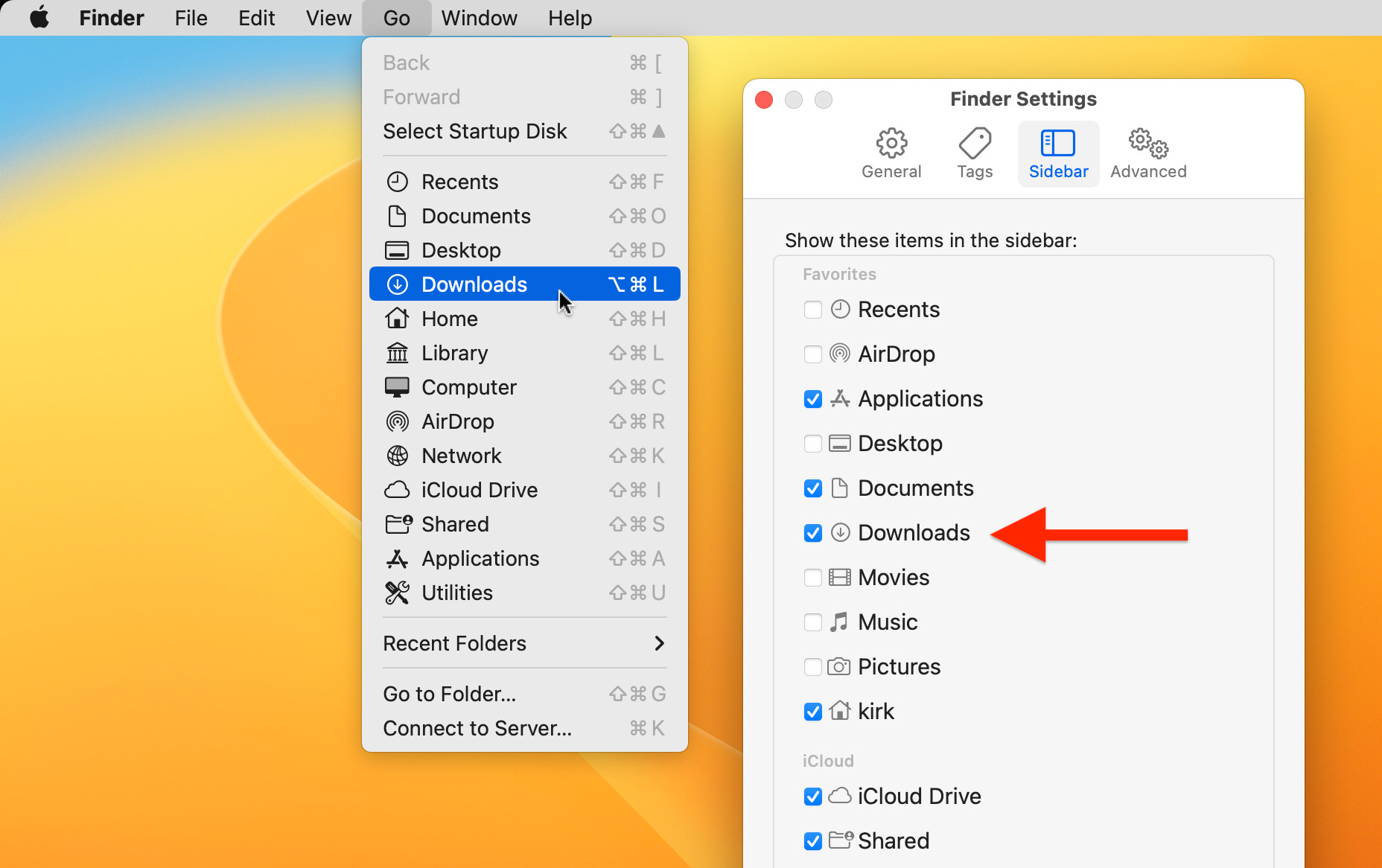
Introduction
Whether you’re a seasoned Mac user or new to the world of macOS, finding and managing your downloads is an essential skill. With the abundance of files we download every day, it’s easy for them to get lost in the shuffle. Thankfully, there are several methods you can use to locate your downloaded files on your Mac.
In this article, we will explore various ways to find and manage your downloads on a Mac. From checking the Downloads folder to using search functions in browsers and accessing download histories, we will cover all the bases. So, if you’re ready to take control of your downloaded files, let’s dive in!
Before we begin with the different methods, it’s important to note that the steps provided in this article are based on the latest versions of macOS and popular web browsers such as Safari, Google Chrome, and Mozilla Firefox. If you have an older version of macOS or a different browser, the steps might vary slightly.
Now, let’s explore the multiple approaches you can take to easily locate and manage your downloaded files on your Mac.
Checking the Downloads Folder
One of the most straightforward methods to find your downloaded files on a Mac is by checking the Downloads folder. When you download a file, it is often saved to this default folder unless you specify a different location.
To access the Downloads folder, follow these simple steps:
- Click on the magnifying glass icon in the top right corner of your screen to open Spotlight Search.
- Type “Downloads” in the search bar and press Enter.
- The Downloads folder will appear in the search results. Click on it to open the folder.
Alternatively, you can also access the Downloads folder through the Finder:
- Open a Finder window by clicking on the Finder icon in your Dock or by pressing Command + N.
- In the left sidebar, you will find a list of shortcuts. Click on “Downloads” to open the folder.
Once you have accessed the Downloads folder, you can browse through the files and organize them according to your preference. You can also use the search bar at the top right corner of the Finder window to locate specific files by name.
It’s important to periodically clear out your Downloads folder to free up storage space on your Mac. You can do this by selecting the files you no longer need and dragging them to the Trash or by right-clicking on the files and selecting “Move to Trash.”
Remember that files in the Downloads folder are stored locally on your Mac’s hard drive. If you delete a file from this folder, it will be permanently removed from your system unless you have a backup. Therefore, make sure to double-check the files you are deleting to avoid losing important data.
Using the Finder Search
If you are unable to locate a specific file in the Downloads folder, you can use the Finder search function to quickly find it. The Finder search allows you to search for files based on various criteria, including file name, file type, and date modified.
To use the Finder search to locate your downloaded files, follow these steps:
- Click on the search bar at the top right corner of the Finder window. This will activate the search function.
- Type in the name or a keyword related to the file you are looking for. For example, if you downloaded a Word document, you can type “.docx” to filter for that file type.
- As you type, the search results will automatically update to display the matching files. You can further refine the search results by using the options provided below the search bar, such as “Kind” or “Date Modified”.
If you still can’t find the file you’re looking for, make sure to check that you haven’t accidentally selected a specific location within the Finder search parameters. You can do this by clicking on “This Mac” under the search bar, which will search your entire computer instead of just a specific folder or location.
The Finder search function is a powerful tool that can help you quickly locate and retrieve your downloaded files. It’s especially useful when you have a large number of downloads or when you need to find a specific file among multiple folders and locations on your Mac.
By mastering the Finder search, you can save time and effort in searching for your downloaded files, allowing you to focus on your tasks and projects without the frustration of manually browsing through folders.
Searching in Safari
If you frequently use Safari as your web browser on your Mac, you can take advantage of its built-in search feature to find your downloaded files. Safari provides a convenient way to search for specific downloads within the browser itself.
To search for downloaded files in Safari, follow these steps:
- Open Safari on your Mac.
- In the top menu, click on “History” and then select “Show Downloads” from the dropdown menu. Alternatively, you can use the keyboard shortcut Option + Command + L.
- A Downloads window will appear, displaying a list of your recent downloads.
- At the top right corner of the Downloads window, you will find a search bar. Here, you can enter keywords or the name of the file you are looking for.
- As you type, the Downloads window will filter the results and display only the files that match your search query.
- If you want to clear the search and view all the downloads again, you can click on the “x” button at the right side of the search bar or simply delete the text in the search bar and press Enter.
Using Safari’s built-in search feature is a quick and efficient way to locate specific downloads without needing to open the Downloads folder or use external search functions. It’s especially useful when you remember the file’s name or some keywords related to it.
Additionally, the Downloads window in Safari also provides useful information about each file, such as the file name, file size, and the date it was downloaded. This can help you easily identify the desired file among your download history.
By utilizing Safari’s search feature, you can save time and effort in locating your downloaded files, ensuring that you can access them whenever you need them.
Searching in Google Chrome
If you’re a Google Chrome user, you can leverage the browser’s search functionality to quickly locate your downloaded files. Google Chrome provides a seamless way to search for specific downloads within the browser itself.
To search for downloaded files in Google Chrome, follow these steps:
- Open Google Chrome on your Mac.
- In the top menu, click on the three-dot icon to open the menu, then select “Downloads” from the dropdown menu. Alternatively, you can use the keyboard shortcut Command + Shift + J.
- A new tab will open, displaying your download history in Chrome.
- At the top right corner of the Downloads tab, you will find a search bar. Here, you can enter keywords or the name of the file you are looking for.
- As you type, Google Chrome will filter the results and display only the files that match your search query.
Using Google Chrome’s built-in search feature makes it convenient to find specific downloads without the need to navigate through multiple folders or use external search functions. It’s especially helpful when you know the file’s name or certain keywords related to it.
Furthermore, the Downloads tab in Google Chrome provides additional details about each file, such as the file name, file size, and the date it was downloaded. This information can assist you in quickly identifying the desired file from your download history.
By taking advantage of Google Chrome’s search feature, you can save time and streamline the process of locating your downloaded files, ensuring that you can access them whenever you need them.
Searching in Mozilla Firefox
If you prefer using Mozilla Firefox as your web browser on your Mac, you can utilize its search functionality to locate your downloaded files. Firefox provides a convenient way to search for specific downloads within the browser itself.
To search for downloaded files in Mozilla Firefox, follow these steps:
- Open Mozilla Firefox on your Mac.
- In the top menu, click on the three-line icon to open the menu, then select “Library” and click on “Downloads”. Alternatively, you can use the keyboard shortcut Command + Shift + Y.
- A new tab will open, displaying your download history in Firefox .
- As you type, Mozilla Firefox will filter the results and display only the files that match your search query.
By using Mozilla Firefox’s built-in search feature, you can easily find specific downloads without the need to navigate through folders or use external search tools. This feature is particularly useful when you remember the file’s name or have specific keywords related to it.
Additionally, the Downloads tab in Mozilla Firefox provides useful information about each file, including the file name, file size, and the date it was downloaded. This way, you can quickly identify the desired file from your download history.
By leveraging the search feature in Mozilla Firefox, you can save time and effort in locating your downloaded files, ensuring that you can access them whenever you need them.
Checking Download History in Safari
If you are using Safari as your web browser on your Mac, you can easily review your download history to locate files you have previously downloaded. Checking the download history in Safari allows you to quickly find and manage your downloaded files.
To check your download history in Safari, follow these steps:
- In the top menu, click on “History.”
- A dropdown menu will appear. Towards the bottom of the menu, you will find the “Show All History” option. Click on it.
- A new window will open, displaying your browsing history.
- In the search bar at the top right corner of the history window, you can enter keywords or the name of the file you want to find.
- As you type, Safari will filter the results and display only the history entries that match your search query.
- Scroll through the list to find the specific download you are looking for.
When you locate the desired download in your history, you can click on it to open the file in Safari’s Downloads window. From there, you can access the file and perform actions such as opening or deleting it.
It’s important to note that the download history in Safari only stores the records of files you have downloaded. If you have deleted a file from your Downloads folder, it will no longer appear in the download history.
By checking your download history in Safari, you can easily keep track of the files you have downloaded and quickly retrieve them when needed.
Checking Download History in Google Chrome
If you are using Google Chrome as your web browser on your Mac, you can easily access your download history to view and manage your downloaded files. Checking the download history in Google Chrome allows you to conveniently locate and organize your downloads.
To check your download history in Google Chrome, follow these steps:
- In the top menu, click on the three-dot icon to open the menu.
- From the menu, hover your cursor over “Downloads” and click on it.
- A new tab will open, displaying your download history in Google Chrome.
- You can scroll through the list to find the specific download you are looking for.
- If you want to search for a specific download, you can use the search bar at the top right corner of the Downloads tab. Simply enter keywords or the name of the file you want to find, and the list will be filtered accordingly.
- Clicking on a downloaded file will open it in the default application associated with its file type, allowing you to access and work with the file.
The download history in Google Chrome provides a record of all the files you have downloaded using the browser. It includes details such as the file name, file size, and the date and time of the download. This information can be helpful in quickly identifying and managing your downloaded files.
It’s worth noting that Google Chrome retains your download history even after you have deleted the downloaded files from your computer. Therefore, you can still access the record of your downloads even if the actual files are no longer present in your system.
By checking your download history in Google Chrome, you can easily keep track of your downloaded files, find specific downloads, and perform necessary actions on them according to your needs.
Checking Download History in Mozilla Firefox
If you use Mozilla Firefox as your web browser on your Mac, you have the ability to access your download history within the browser. Reviewing your download history in Mozilla Firefox allows you to easily track and manage your downloaded files.
Here’s how you can check your download history in Mozilla Firefox:
- Launch Mozilla Firefox on your Mac.
- In the top menu, click on the three-line icon to open the menu.
- From the menu, select “Library” and then click on “Downloads.”
- A new tab will open, displaying your download history in Mozilla Firefox.
- If you want to search for a particular download, you can use the search bar at the top right corner of the Downloads tab. Enter keywords or the name of the file you are searching for, and the list will be filtered accordingly.
- Clicking on a downloaded file will open it or reveal it in Finder, depending on its file type and your system settings.
The download history in Mozilla Firefox provides details about each downloaded file, including the file name, file size, and the date and time it was downloaded. This information can assist you in quickly identifying and managing your downloaded files.
Note that the download history in Mozilla Firefox retains a record of your downloads even if you have deleted the downloaded files from your computer. Therefore, you can still access the history of your downloads, even if the actual files are no longer present in your system.
By navigating through your download history in Mozilla Firefox, you can easily keep track of your downloads, locate specific files, and take appropriate actions to manage and organize them according to your preferences.
Using Spotlight Search
If you are using a Mac, one powerful tool at your disposal is Spotlight Search. This built-in feature allows you to search your entire computer, including your downloads, with just a few keystrokes. Using Spotlight Search can save you time and effort by quickly locating specific downloaded files.
Here’s how you can use Spotlight Search to find your downloaded files:
- Press Command + Spacebar to activate Spotlight Search.
- A search bar will appear in the center of your screen.
- Type in the name of the file you want to find or related keywords.
- As you type, Spotlight Search will start displaying results in real-time below the search bar.
- Look for the “Documents” category in the search results and click on it to expand.
- Scroll through the search results to find the downloaded file you are looking for.
- Once you locate the file, you can click on it to open it or access its location in Finder.
Spotlight Search is incredibly versatile, allowing you to find files across your entire Mac, not just in specific folders. This makes it an efficient way to locate downloaded files, even if you don’t remember the specific location where they were saved.
Additionally, Spotlight Search also supports advanced search operators, such as file type filters (e.g., “kind:pdf”) or date filters (e.g., “created:yesterday”). These operators can help you narrow down your search results and find your downloaded files more quickly.
By leveraging the power of Spotlight Search, you can effortlessly locate your downloaded files, saving yourself the time and hassle of manually searching through different folders on your Mac.
Using Terminal
If you’re comfortable working with the command line interface, you can utilize Terminal to efficiently locate and manage your downloaded files on a Mac. Terminal provides a powerful way to interact with your system and perform various tasks, including finding specific files.
Here’s how you can use Terminal to search for downloaded files:
- Open Terminal on your Mac.
- Type the following command and press Enter: cd ~/Downloads
- This command will change the working directory to your Downloads folder.
- Next, you can use various commands to search for files, such as:
- ls – Lists all the files and folders in the current directory.
- ls -l – Lists files and folders in a detailed format (including permissions, size, and modification date).
- ls -a – Lists all files and folders, including hidden ones.
- find . -name "filename" – Searches for a file with a specific name in the current directory and its subdirectories. Replace “filename” with the actual name of the file you’re looking for.
Using Terminal gives you precise control over your search commands and allows for advanced filtering and sorting options. It’s particularly useful when you need to perform complex searches or when you’re familiar with specific Unix commands.
In addition to searching for files, Terminal also allows you to perform various file management operations, such as moving, copying, deleting, and renaming files. This gives you full control over organizing and managing your downloaded files directly from the command line.
Remember to exercise caution when using Terminal, as commands can have significant system-level effects. Double-check your commands before executing them, especially when deleting or modifying files, to avoid unintended consequences.
By leveraging the power of Terminal, you can efficiently search for and manage your downloaded files on your Mac, taking advantage of the flexibility and control that the command line provides.
Locating and managing your downloaded files on a Mac is vital for staying organized and accessing important documents, media files, and more. In this article, we explored various methods to help you find your downloaded files effectively.
We started by checking the Downloads folder, the default location where downloaded files are often saved. By accessing this folder, you can easily browse through your downloads and organize them as needed. Additionally, we explored how to use the Finder search function to search for specific files based on criteria such as file name and file type.
We then delved into searching for downloaded files in popular web browsers such as Safari, Google Chrome, and Mozilla Firefox. Each browser provides built-in search features that allow you to search your download history and quickly locate specific files. This can be incredibly useful when you remember keywords related to the file or its name.
Moreover, we discussed how to leverage Spotlight Search, a powerful tool on macOS, to search your entire computer, including downloaded files. This method is ideal when you need to find files scattered across different folders and locations.
Lastly, we explored using Terminal, the command line interface on a Mac, to search for and manage downloaded files. Terminal offers advanced control, allowing for precise search commands and file manipulation operations.
By utilizing these various methods, you can save time and effort in locating your downloaded files on your Mac. Remember to regularly clear out unnecessary files from your Downloads folder to free up storage space and keep your system running smoothly.
Whether you prefer the simplicity of browsing your Downloads folder, the convenience of browser-specific search functions, the versatility of Spotlight Search, or the power of Terminal, there’s a method that suits your preferences and workflow. Experiment with these techniques to find the most efficient way to manage your downloaded files on your Mac.
Leave a Reply Cancel reply
Your email address will not be published. Required fields are marked *
Save my name, email, and website in this browser for the next time I comment.
- Crowdfunding
- Cryptocurrency
- Digital Banking
- Digital Payments
- Investments
- Console Gaming
- Mobile Gaming
- VR/AR Gaming
- Gadget Usage
- Gaming Tips
- Online Safety
- Software Tutorials
- Tech Setup & Troubleshooting
- Buyer’s Guides
- Comparative Analysis
- Gadget Reviews
- Service Reviews
- Software Reviews
- Mobile Devices
- PCs & Laptops
- Smart Home Gadgets
- Content Creation Tools
- Digital Photography
- Video & Music Streaming
- Online Security
- Online Services
- Web Hosting
- WiFi & Ethernet
- Browsers & Extensions
- Communication Platforms
- Operating Systems
- Productivity Tools
- AI & Machine Learning
- Cybersecurity
- Emerging Tech
- IoT & Smart Devices
- Virtual & Augmented Reality
- Latest News
- AI Developments
- Fintech Updates
- Gaming News
- New Product Launches
Learn To Convert Scanned Documents Into Editable Text With OCR
Top mini split air conditioner for summer, related post, comfortable and luxurious family life | zero gravity massage chair, when are the halo awards 2024, what is the best halo hair extension, 5 best elegoo mars 3d printer for 2024, 11 amazing flashforge 3d printer creator pro for 2024, 5 amazing formlabs form 2 3d printer for 2024, related posts.
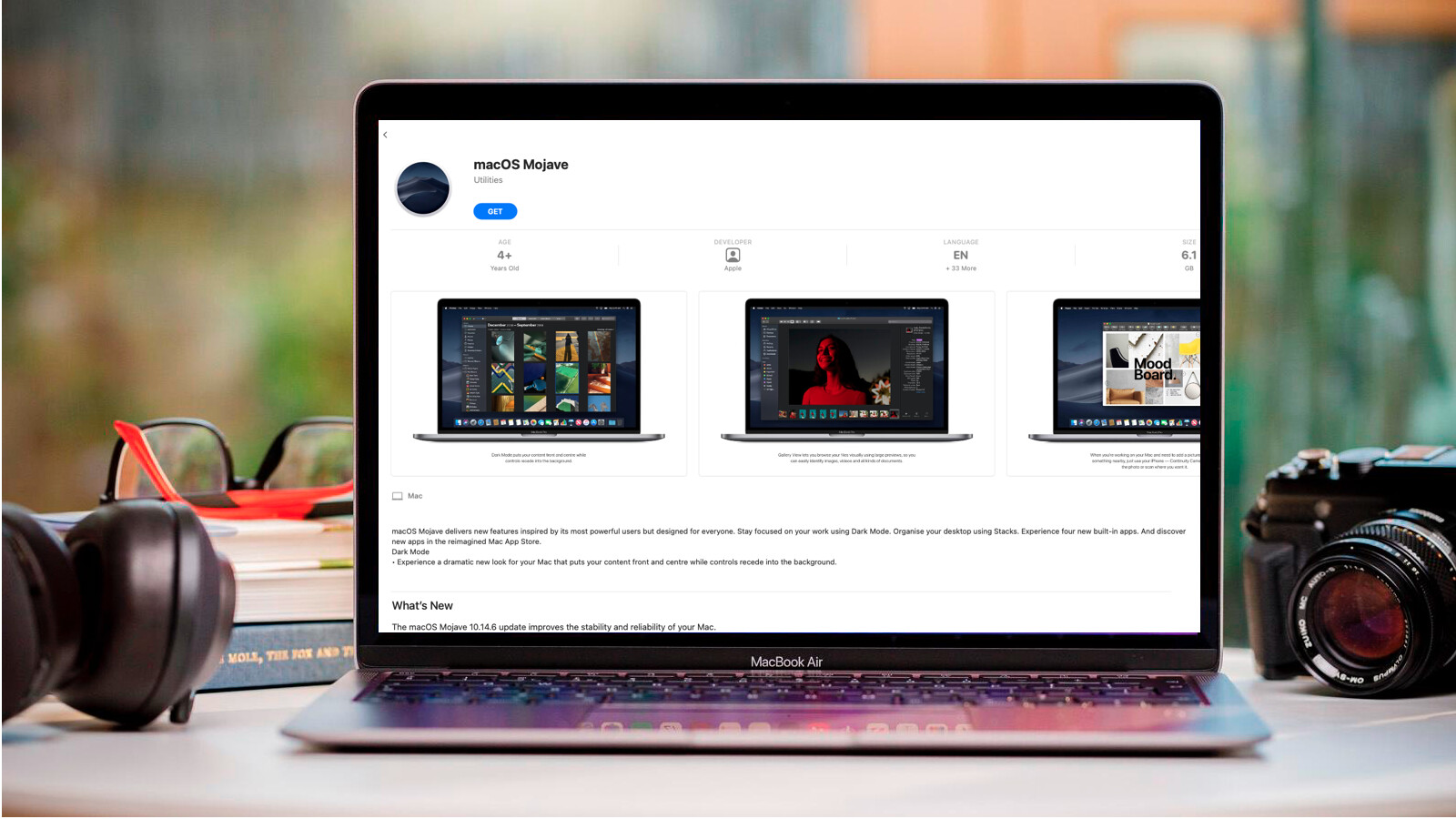
How To Download Older Version Of Mac OS
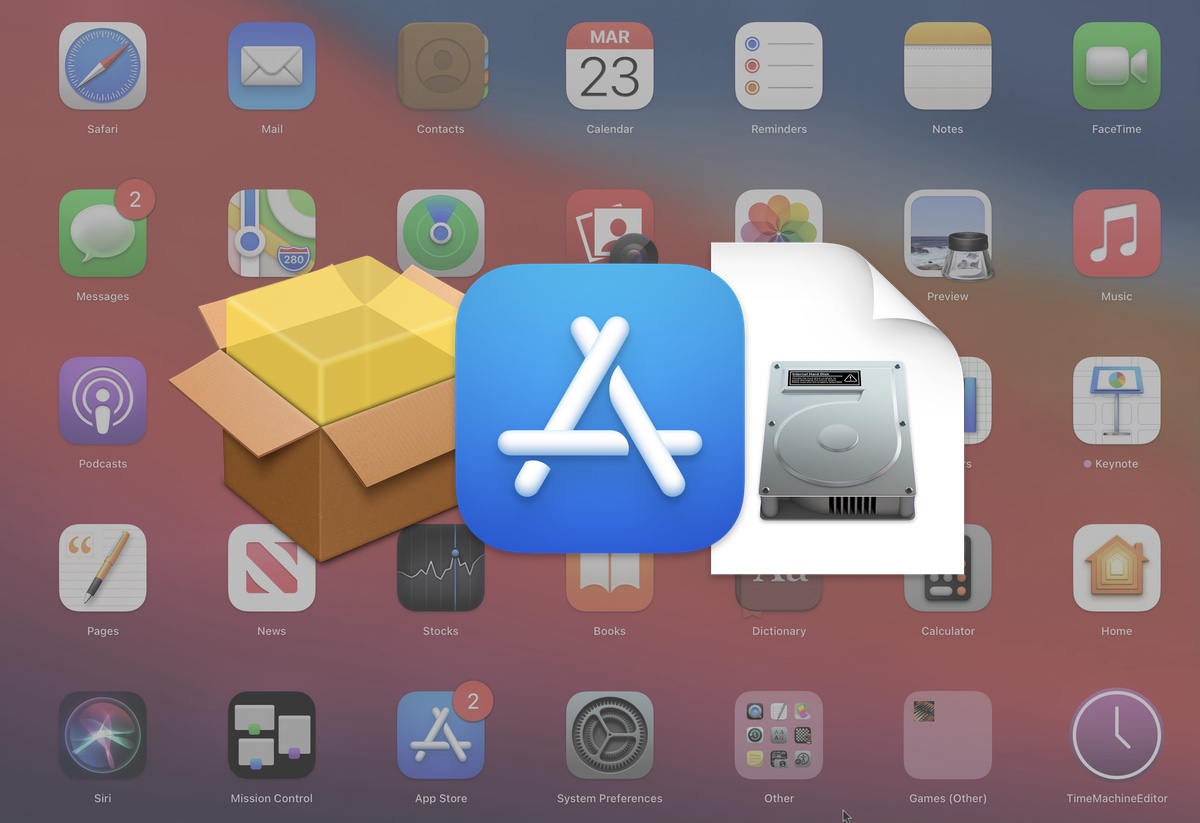
How To Download An App On Mac
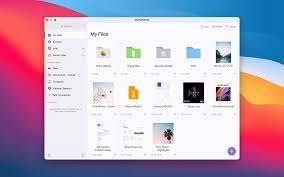
How To Download Documents On Mac

How To Download HBO Max Movies On Mac

How To Download Movies On Prime Video On Mac

How To Download YouTube Videos On Mac

How To Download YouTube Music To Mac
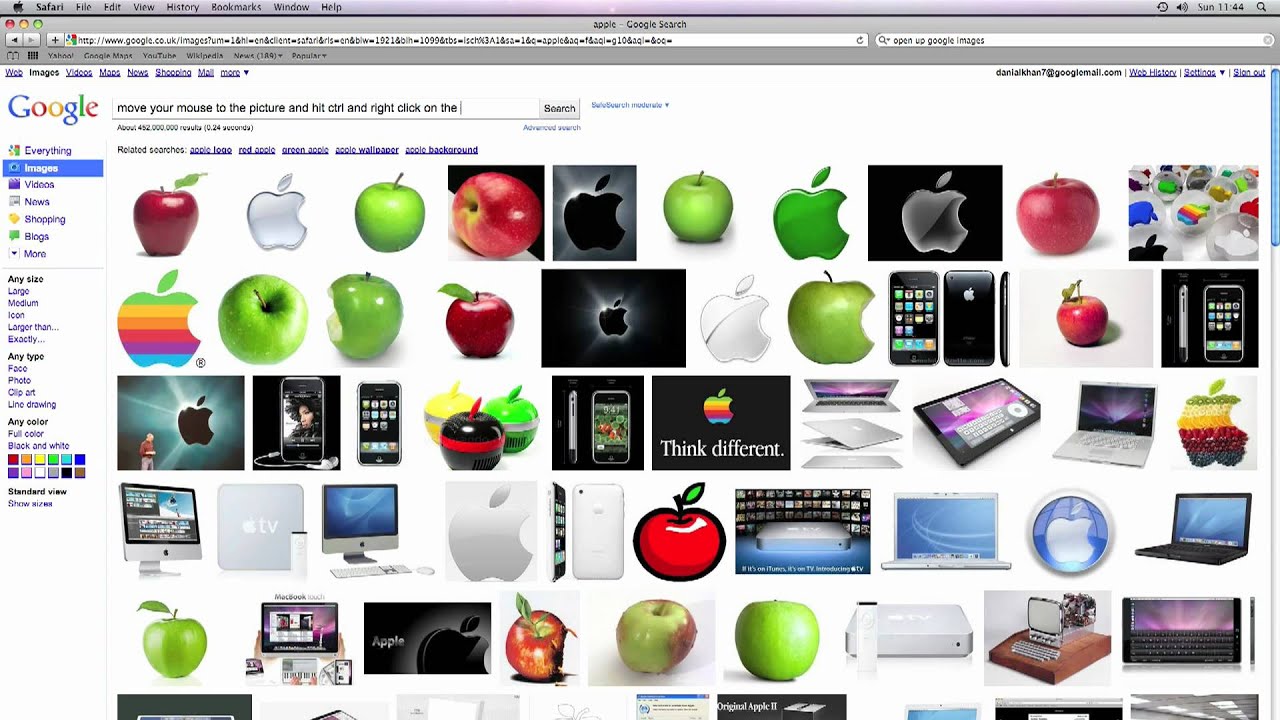
How To Download Images From Google On Mac
Recent stories.

Fintechs and Traditional Banks: Navigating the Future of Financial Services

AI Writing: How It’s Changing the Way We Create Content

How to Find the Best Midjourney Alternative in 2024: A Guide to AI Anime Generators

How to Know When it’s the Right Time to Buy Bitcoin

Unleashing Young Geniuses: How Lingokids Makes Learning a Blast!

- Privacy Overview
- Strictly Necessary Cookies
This website uses cookies so that we can provide you with the best user experience possible. Cookie information is stored in your browser and performs functions such as recognising you when you return to our website and helping our team to understand which sections of the website you find most interesting and useful.
Strictly Necessary Cookie should be enabled at all times so that we can save your preferences for cookie settings.
If you disable this cookie, we will not be able to save your preferences. This means that every time you visit this website you will need to enable or disable cookies again.
How To Use Delta Emulator and Play Nintendo Games on iOS
- While emulators are legal in the U.S., ROMs are a bit more complicated.
- The Delta app requires iOS 14 or later.
- The app is also available for iPad, Mac, and Vision Pro.

Gamers, your time is here: the Delta emulator app is now available for iOS, and with it arrives a wealth of emulation and features. This expansive app hosts an impressive selection of classic video game consoles, providing the ability to play thousands of retro games on your iPhone. Below, I’ll show you everything you need to know to start gaming.
What to Know About the Delta Emulator
Apple finally eased restrictions on emulators, and Delta is the second Apple-approved option to be officially listed on the App Store. What I love about it is that it’s 100% free. You can play a wide variety of retro Nintendo games without having to sit through ads—note that very few free emulators offer an ad-free experience. You can learn more about the Delta emulator here .
What Emulators Are Available on the Delta App?
The following emulators (game systems) are available through the Delta app:
- Nintendo Entertainment System (NES)
- Super Nintendo Entertain System (SNES)
- Nintendo 64
- Game Boy and Game Boy Color
- Game Boy Advance
- Nintendo DS
How To Get Nintendo DS Games on Delta Game Emulator?
While every emulator available within the app works as is, there are specific BIOS files that you’ll need for the Nintendo DS emulator. I can’t link to them for copyright reasons, but you can easily find them on any search engine. After you download the necessary files, remember to select Save to Files from the Share menu.
The BIOS files needed for the Nintendo DS emulator are as follows:
- firmware.bin
Time needed: 2 minutes
Once you’ve downloaded these files, adding them to the Delta emulator is easy—here’s how:
From here, the Nintendo DS emulator will be fully operational. However, note that you may need to use iTunes File Transfer to add games—DS ROMs are typically several gigabytes large. Downloading them through your iPhone may be a hassle, so I’ll cover this more below.
How to Download ROMs for the Delta Emulator
Again, pirating officially licensed games breaks copyright laws, so I won’t be linking to them. However, homebrew games, and even some ROM hacks, are typically okay to share. Places like Homebrew Hub can have a library of legal, independently created games to play.
ROMs will either be in a compressed file (such as .ZIP) or a rather obvious file extension (.GBA for a Game Boy Advanced game, for example). I’ve had no problems importing both, but mileage may vary on compressed files. Should one give you issues, try extracting the file.
With that in mind, there are two primary ways to add ROMs to the Delta app: either through iTunes/Folder or the iOS Files app. Let’s take a look at both, as one can be easier than the other.
1. Adding ROMs Via the iOS Files App
Personally, this is the easiest way to add ROMs since it doesn’t require a computer. However, guiding your ROM downloads to the right place can be tricky.
For this how-to guide, I’ll download the game Sips from Homebrew Hub.
- First, navigate to the Homebrew Hub page for Sips .
- Scroll down and click Download Rom .
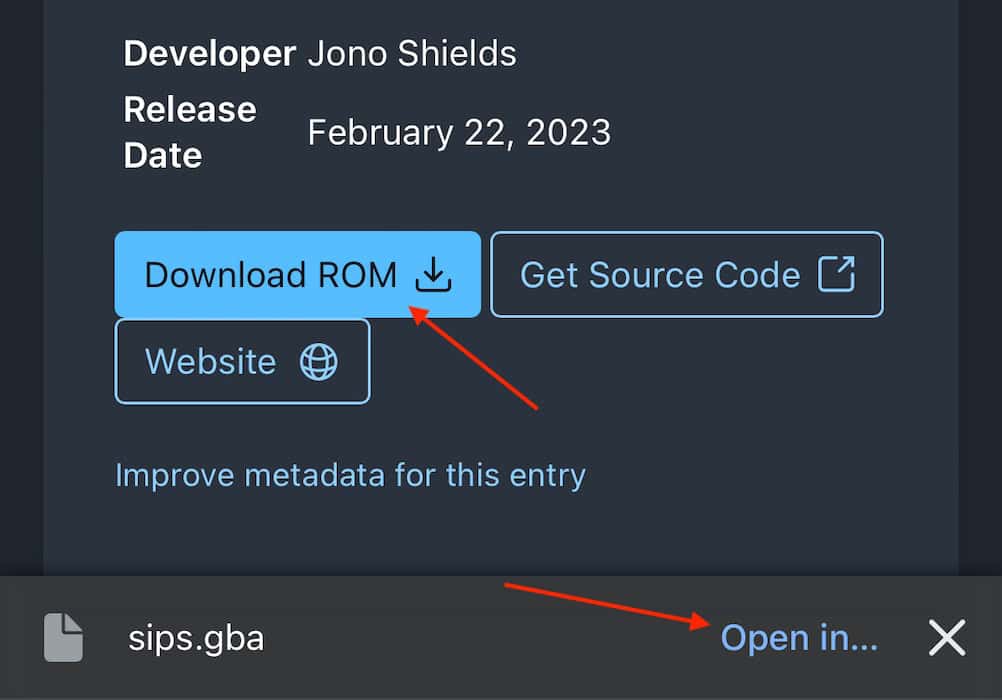
This method can be spotty depending on the browser you use, so make sure the ROM file makes its way to your Files app.
2. Adding ROMs Using iTunes
This method may be easier for those who have a hard time downloading ROMs directly on their iPhone, although you’ll have to use a Mac or PC. Let’s take a look.
- First, download the ROM.
- Next open iTunes .
- Navigate to the iPhone icon.
- Select File Sharing from the left-hand column.
- Click the Delta app and then Drag and Drop the ROMs you want into this section.
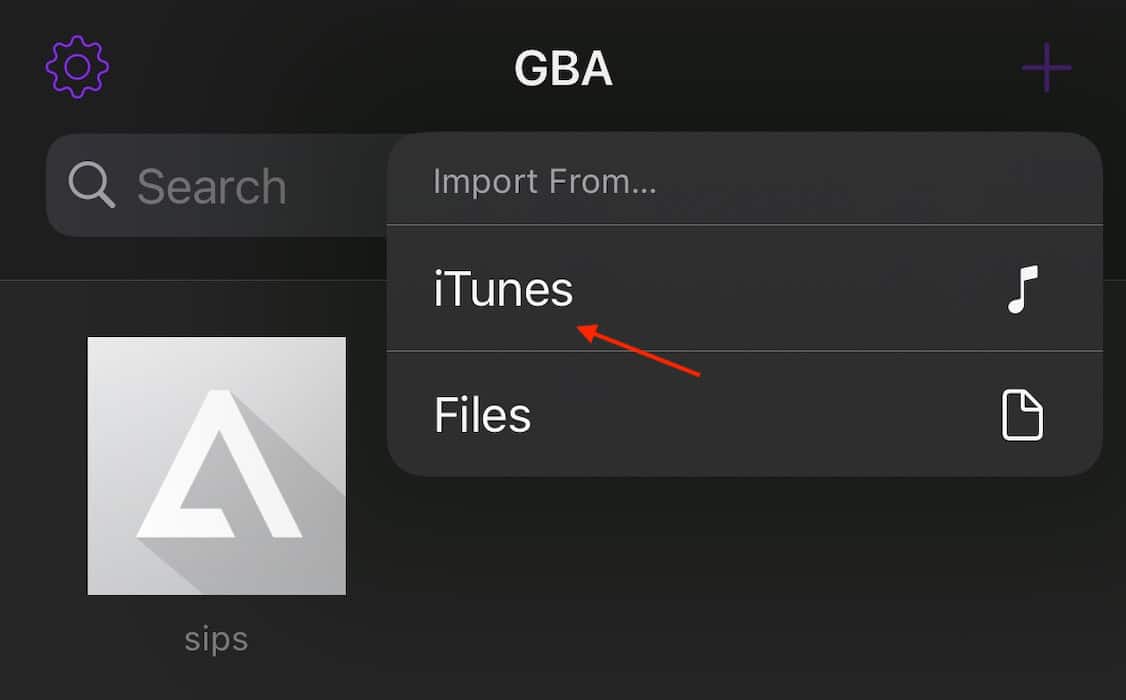
3. Adding ROMs Using Finder
If your Mac is running macOS Catalina or later, you’ll need to use Finder.
- Connect your iPhone to your Mac, then select your iPhone from a Finder window.
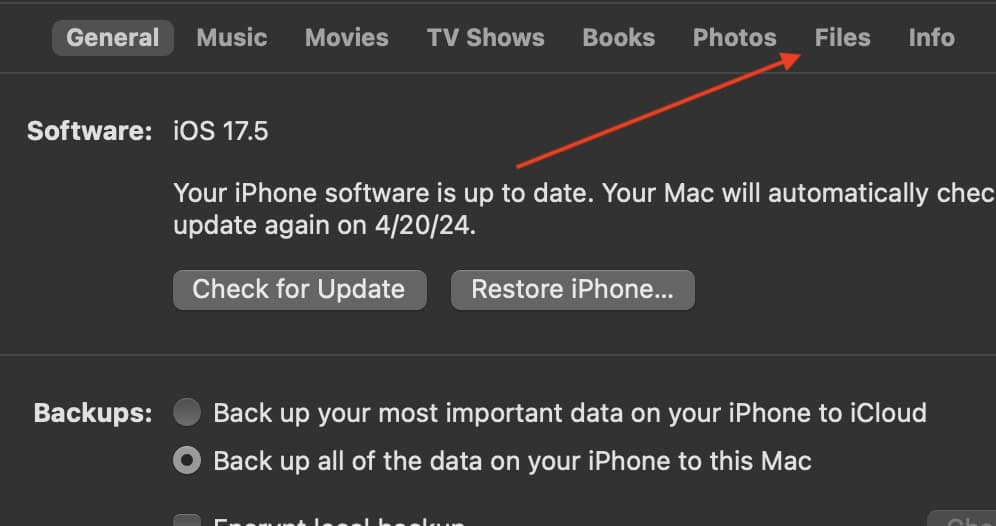
As you can probably tell, it’s pretty easy to add ROMs to the Delta app once you have the files in the correct location. The hardest part is probably getting them there.
How to Add Emulator Skins
One of the cooler features of Delta is it lets you change emulator skins. This is really easy to do, plus you can find tons of skins on sites like Delta GitHub . Adding skins is similar to adding ROMs, so again, ensure the skins are in your Files folder.
- You can now select the imported skin/s on Delta.
How to Remap Controllers in Delta
If you need to remap a controller, simply follow these steps:
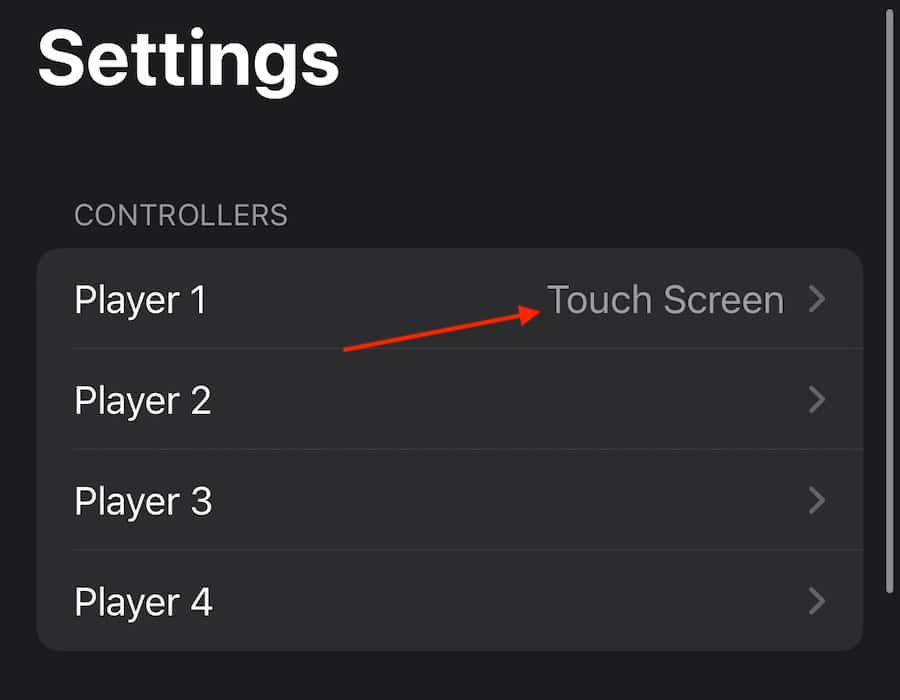
- Select NES to open the drop-down menu and choose the controller you want to edit.
- Now, tap the button you want to change and press a button on the physical controller to remap it.
Controllers Supported By Delta App
The Delta app will support any third-party controller that works with iOS. However, here are some popular examples:
- Nintendo Switch Online Controller
- Nintendo Switch Joy-Cons
- Nintendo Switch Pro Controller
- Xbox Wireless Controller (Series X and S)
- Xbox Adapter Controller
- Xbox Elite Wireless Controller Series 2
- Xbox Wireless Controller with Bluetooth Model 1708
- Playstation 4 and 5 Wireless Controllers
Adding a controller is usually as simple as navigating to Settings > Bluetooth on your iPhone, checking if the controller is discoverable, and then selecting it from the Other Devices list.
Additional Controls and Options
Once a game is running, you can open an additional menu that lets you fast-forward through scenes, hold down buttons, and even enable cheats. You’ll see this menu on the main screen while playing. It’s also where you’ll find your options to save and load games. You can save games within emulators, although I suggest using the Delta app’s Save function—it’s more reliable and accurate. Take a look around this section to see what you find.
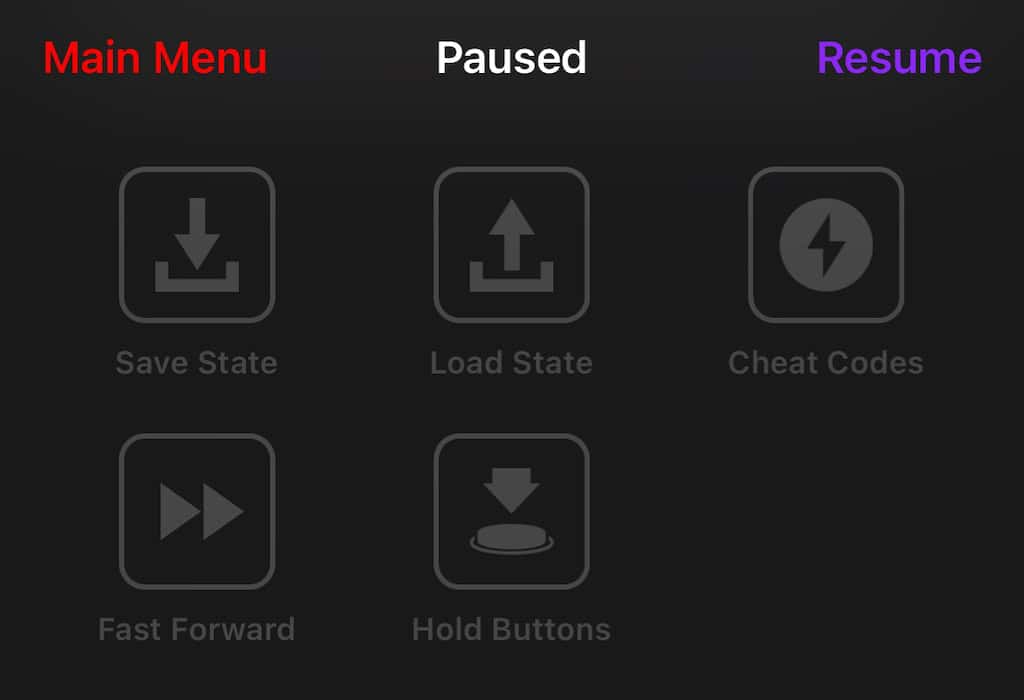
While Android users may laugh over Apple slowly entering the world of emulation, the fact is it’s never too late to start. You may also want to know about the best Playstation 2 emulators for iOS .
Leave a Reply Cancel reply
You must be logged in to post a comment.
This site uses Akismet to reduce spam. Learn how your comment data is processed .
- Nick deCourville
- a. Send us an email
- b. Anonymous form
- Buyer's Guide
- Upcoming Products
- Tips / Contact Us
- Podcast Instagram Facebook Twitter Mastodon YouTube Notifications RSS Newsletter
How to Access the Download Manager in Safari for iOS
With iOS 13, Apple has brought a similar feature to the mobile version of its Safari browser in the form of the Download Manager. Now, when you choose to download a file, such as an image or document, a little download icon is displayed in the top right corner of the screen.
You can tap the icon to check the status of your downloads, and tapping the magnifying glass next to a file will open its folder location, whether that's on your device or in the cloud.
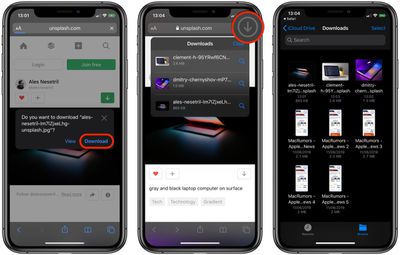
Get weekly top MacRumors stories in your inbox.
Popular Stories

Apple Announces 'Let Loose' Event on May 7 Amid Rumors of New iPads
Apple Releases Open Source AI Models That Run On-Device

iOS 18 Rumored to Add These 10 New Features to Your iPhone

Apple Cuts Vision Pro Shipments as Demand Falls 'Sharply Beyond Expectations'

Apple Finally Plans to Release a Calculator App for iPad Later This Year
Next article.

Our comprehensive guide highlighting every major new addition in iOS 17, plus how-tos that walk you through using the new features.

App Store changes for the EU, new emoji, Podcasts transcripts, and more.

Get the most out your iPhone 15 with our complete guide to all the new features.
A deep dive into new features in macOS Sonoma, big and small.

Revamped models with OLED displays, M3 chip, and redesigned Magic Keyboard accessory.

Updated 10.9-inch model and new 12.9-inch model, M2 chip expected.

Apple's annual Worldwide Developers Conference will kick off with a keynote on June 10.

Expected to see new AI-focused features and more. Preview coming at WWDC in June with public release in September.
Other Stories

8 hours ago by Tim Hardwick

1 day ago by Joe Rossignol

1 day ago by MacRumors Staff

2 days ago by Joe Rossignol

3 days ago by Tim Hardwick
Advertisement
Supported by
Apple Says It Was Ordered to Pull WhatsApp From China App Store
Apple said it removed WhatsApp and Threads from its China app offerings Friday on Beijing’s orders, amid technological tensions between the U.S. and China.
- Share full article

By Tripp Mickle and Mike Isaac
Tripp Mickle reports on Apple, and Mike Isaac on Meta.
Apple said it pulled the Meta-owned apps WhatsApp and Threads from its app store in China on Friday on government orders, potentially escalating the war over technology between the United States and China.
The iPhone maker said that China’s internet regulator, the Cyberspace Administration, ordered the removal of WhatsApp and Threads from its app store because of national security concerns. Apple said that it complied because “we are obligated to follow the laws in the countries where we operate, even when we disagree.”
A Meta spokesman directed requests for comment to Apple. The Wall Street Journal earlier reported Apple’s removal of the apps.
A person briefed on the situation said the Chinese government had found content on WhatsApp and Threads about China’s president, Xi Jinping, that was inflammatory and violated the country’s cybersecurity laws. The specifics of what was in the content was unclear, the person said.
An Apple spokesman denied that the Chinese government ordered the apps removed because of content on WhatsApp and Thread about Mr. Xi that was inflammatory.
Several other global messaging apps had also been removed from Apple’s App Store in China on Friday, including Signal, which is based in the United States, and Telegram, which is based in Dubai, according to Appfigures, a market research firm that analyzes the digital economy. Signal didn’t immediately have a comment and Telegram didn’t respond to a request for comment.
The actions thrust Apple and Meta into an intensifying tussle over technology between the United States and China. In the United States, the House of Representatives was preparing to vote on a bill as soon as this weekend that would force the Chinese internet company ByteDance to sell its popular video app TikTok or have it be banned in the United States. U.S. lawmakers have said TikTok poses a national security threat because of its ties to China. Chinese officials have condemned the push to force a TikTok sale.
The White House has also recently worked to restrict Beijing’s access to advanced technologies that could be used in war, as well as extend restrictions to American dollars that are used to finance the development of such technologies within Chinese borders. Beijing has responded by banning memory chips from the U.S. chipmaker Micron and moving to curb other American chip companies’ sales.
China has long blocked American websites including Facebook and Instagram by using an elaborate system called the Great Firewall. While WhatsApp, one of the world’s most popular messaging services, and Threads, an X-like app for digital conversation, were permitted in app stores, they were not used widely in China. The apps were dwarfed by Chinese ones such as WeChat , which is owned by the Chinese internet company Tencent.
Still, Chinese users had been able to download WhatsApp and use it with the assistance of a virtual private network, or VPN, which are used to set up secure web connections and view prohibited content inside China.
WhatsApp had been downloaded 15 million times on iPhones in China since 2017, while Threads had been downloaded 470,000 times, according to Appfigures.
Apple has been more vulnerable than most companies to the rising tensions between the United States and China. It became one of the world’s most valuable public companies by tapping China’s vast work force and manufacturing muscle to build its iPhones and then selling the devices to the country’s growing middle class. China now accounts for about a fifth of Apple’s annual sales, more than $68 billion last year.
For years, Apple has bowed to Beijing’s demands that it block an array of apps, including newspapers, VPNs and encrypted messaging services. It also built a data center in the country to house Chinese citizens’ iCloud information, which includes personal contacts, photos and email.
As the relationship between the United States and China deteriorated, Apple began diversifying its supply chain and has started assembling iPhones, AirPods and Apple Watches in India and Vietnam.
Tim Cook, Apple’s chief executive, has been in Asia this week, where he has visited suppliers in Vietnam and spoke with Indonesia’s president about building a manufacturing plant there.
For Meta, any fallout will likely be less direct, given that many of its apps were already banned in China. Still, Meta makes money from Chinese companies like Temu and Shein , which pay to place advertising inside Instagram and Facebook.
Meta and Apple have long had an uneasy corporate relationship . Apple has introduced greater restrictions on the types of tracking that companies could do across its devices, severely curtailing Meta’s ability to gain insights into user behavior for its digital advertising business. Mark Zuckerberg, Meta’s chief executive, has publicly railed against what he feels are Apple’s overly restrictive privacy guidelines.
In the United States, the moves against TikTok have gained momentum in recent days, with House Speaker Mike Johnson packaging a measure to force ByteDance to sell the app with other bills on foreign aid for Ukraine, Israel and Taiwan.
House lawmakers are expected to vote Saturday on the package of legislation. If the package passes, the measures will be sent as a single bill to the Senate, which could vote soon after. President Biden has said he would sign TikTok legislation into law if it reaches his desk.
Tripp Mickle reports on Apple and Silicon Valley for The Times and is based in San Francisco. His focus on Apple includes product launches, manufacturing issues and political challenges. He also writes about trends across the tech industry, including layoffs, generative A.I. and robot taxis. More about Tripp Mickle
Mike Isaac is a technology correspondent for The Times based in San Francisco. He regularly covers Facebook and Silicon Valley. More about Mike Isaac

COMMENTS
Find a Downloaded Item: If you have a cluttered Mac and can't find your downloaded file, just click the magnifying glass next to the file name to open it in Finder. Remove a downloaded item: If you want to remove a single item from the list, Control-click the item and select Remove from List .
Here's how to do it. First, open the Safari application on your Mac. In any Safari window, look to the right of the address bar for an icon that looks like a downward-pointing arrow in a circle. If you see it, click it or press Option+Command+L. (If you don't see the arrow icon, Safari does not have any download history to display.)
The Menu Bar: With Finder in the foreground, click Go > Downloads in the menu bar at the top of the screen. The Finder Sidebar: In any Finder window, look in the sidebar on the left side of the window and click "Downloads" in the list of "Favorites." If "Downloads" isn't listed in Favorites, you can drag the icon for the Downloads folder into ...
Pause a download: Click the Stop button to the right of the filename in the downloads list. To resume, click the Resume button . Find a downloaded item on your Mac: Click the magnifying glass next to the filename in the downloads list. If you move a file or change the download location after downloading it, Safari can't find the file.
We understand that you're having some issues locating the files that you downloaded in Safari on your Mac. To change where downloaded files are saved on your Mac, go to Safari > Preferences > General > File download location. When you do this, you can also see which folder was selected previously and that folder is where you'll find your downloads.
Navigate to the Menu Bar: Once Safari is open, look at the top of the screen for the Menu Bar. Click on "View" in the Menu Bar to reveal a dropdown menu. Access the Downloads Window: In the "View" dropdown menu, locate and click on "Show Downloads" (alternatively, you can use the keyboard shortcut Command + Option + L).
Alternatively, you can click on the Go menu in the menu bar, choose Downloads, or press the shortcut Command + Option + L. Inside the Downloads folder, you will see a list of all the downloaded files and folders. The files appear in chronological order with the newest downloads at the top.
In Safari, you can click on anything identified as a download link, or Control-click an image or other object on the page. To choose to download a linked file (and some webpage items can't be downloaded, in Safari click the Show Downloads button near the top-right corner of the web browser window.
Here's how to manage and remove download items in Safari for Mac. Safari downloads on Mac: hide. 1) View your downloads. 2) Pause and resume downloads. 3) Remove downloads manually. 4) Remove downloads automatically. 5) Change the download location.
Catalina Quick Tip. In macOS Catalina's Safari web browser, you can choose where downloaded files are stored. By default, they're deposited in your Downloads folder.
This list makes it easy for you to access your Safari downloads. It further helps you keep track of any currently downloading and already downloaded files. To view Safari downloads in Safari, click the Download button (if you do not see the button, your list is empty). The Download button is located near the top-right corner of the Safari window.
Launch Safari browser on your Mac. Select Safari -> Preferences… from the menu bar. In the General tab, click the dropdown menu next to File download location. Select Ask for Each Download, or ...
Here's how to view and clear it. Viewing Mac Download History. ... This isn't just Safari downloads. Any app that lets you download files will show up here. This can include torrents, cat ...
To do so, go to Safari > Settings > General and select the File download location tab and select one. How to view your Safari downloads on iPhone/iPad. Select the Browse tab and tap On My iPhone or On My iPad. Go to Downloads folder and choose the file you were looking for. Note: There are other folders under the Browse tab.
To do this, open Safari, click on Safari in the top toolbar and then click preferences, then click General. On this menu click the drop down box next to File download location, and then select a ...
This provides a convenient way to view and open downloaded files without navigating through multiple menus. Keyboard Shortcut: For users who prefer keyboard shortcuts, accessing downloads on Safari is as simple as pressing "Command" + "Option" + "L" on a Mac. This key combination instantly opens the downloads window, allowing users to quickly ...
When the taskbar at the top of the screen says Finder (and it will when you are on your Mac's home screen), click File, then click New Finder Window. Select New Finder Window. Steven John/Business ...
Access the Downloads Window: Begin by launching Safari on your Mac or iOS device. From the top menu, click on "Window" and select "Downloads" from the dropdown menu. ... The ability to view recent downloads in Safari provides a valuable resource for efficiently accessing and managing downloaded files, ensuring that users can easily retrieve ...
Alternatively, you can use Finder or Terminal to search for recently downloaded files. Q2. How do I view my download history in Safari on Mac? A: To view your download history in Safari on Mac, click on the Safari menu bar, then click on the Downloads icon. This will show you all the files you've downloaded. Q3.
If you just downloaded a file from Safari. Next to the search field in Safari, tap the Page Settings button. Tap the Downloads button. Published Date: October 13, 2023. If you download a file onto your iPhone or iPad from the internet, you can find it in your Downloads folder in the Files app.
Safari Browser will not download files. The download icon pops up quickly on Safari address bar, then disappears, ~0.5 sec. File cannot be found anywhere. ... Apple may provide or recommend responses as a possible solution based on the information provided; every potential issue may involve several factors not detailed in the conversations ...
In macOS Safari, you can choose where downloaded files are deposited. By default they're located in your Downloads folder, but you can change the location.
iOS 17 brings big updates to Phone, Messages, and FaceTime that give you new ways to express yourself as you communicate. StandBy delivers a new full-screen experience with glanceable information designed to view from a distance when you turn iPhone on its side while charging. AirDrop makes it easier to share and connect with those around you and adds NameDrop for contact sharing. Enhancements ...
By checking your download history in Safari, you can easily keep track of the files you have downloaded and quickly retrieve them when needed. Checking Download History in Google Chrome. If you are using Google Chrome as your web browser on your Mac, you can easily access your download history to view and manage your downloaded files.
Since I used Google Chrome, the Download ROM button showed up at the bottom of the screen. After downloading, click Open In and select Save to Files . Now, navigate back to the Delta app. Tap the ...
The Downloads screen in Safari settings also includes an option to Remove Download List Items automatically After one day (the default), Upon successful download, or Manually. Tag: Safari Related ...
Swift's latest album, "The Tortured Poets Department," which dropped on Friday, became the most-streamed album on its first day across Spotify, Amazon Music, and Apple Music.
Still, Chinese users had been able to download WhatsApp and use it with the assistance of a virtual private network, or VPN, which are used to set up secure web connections and view prohibited ...